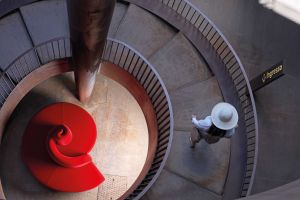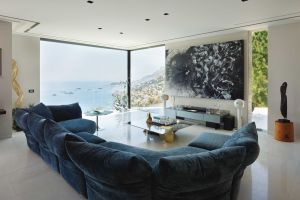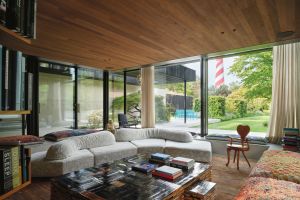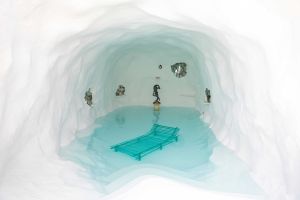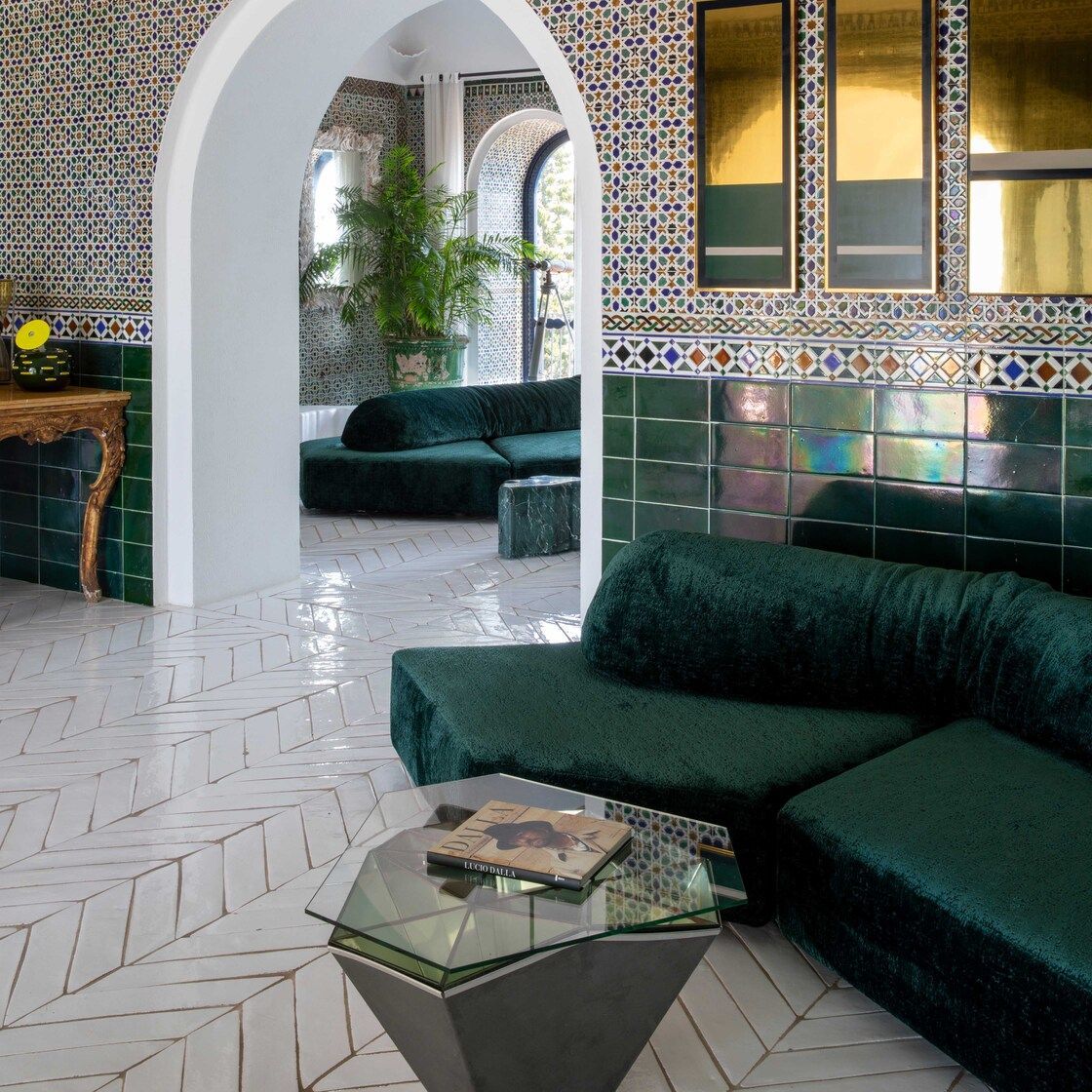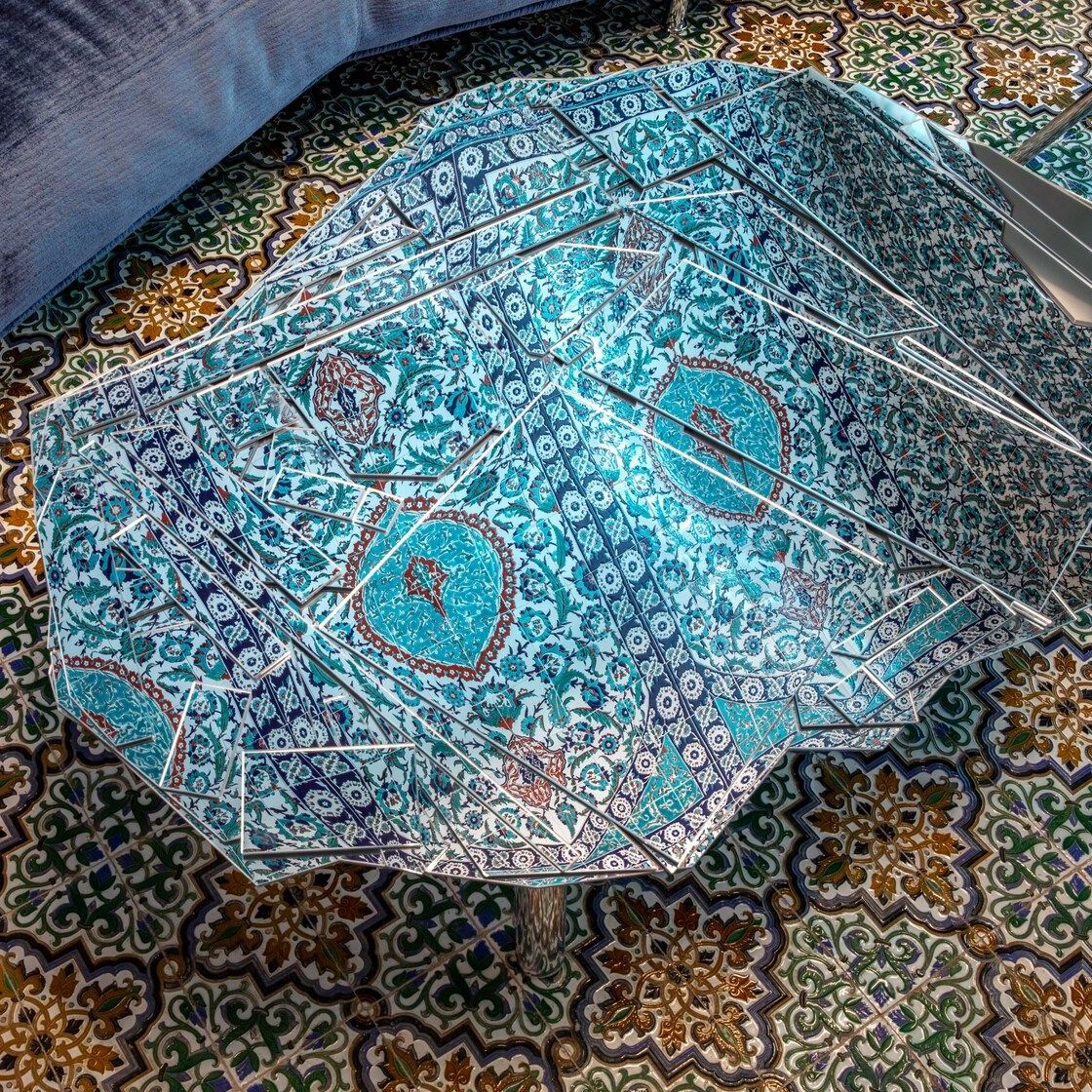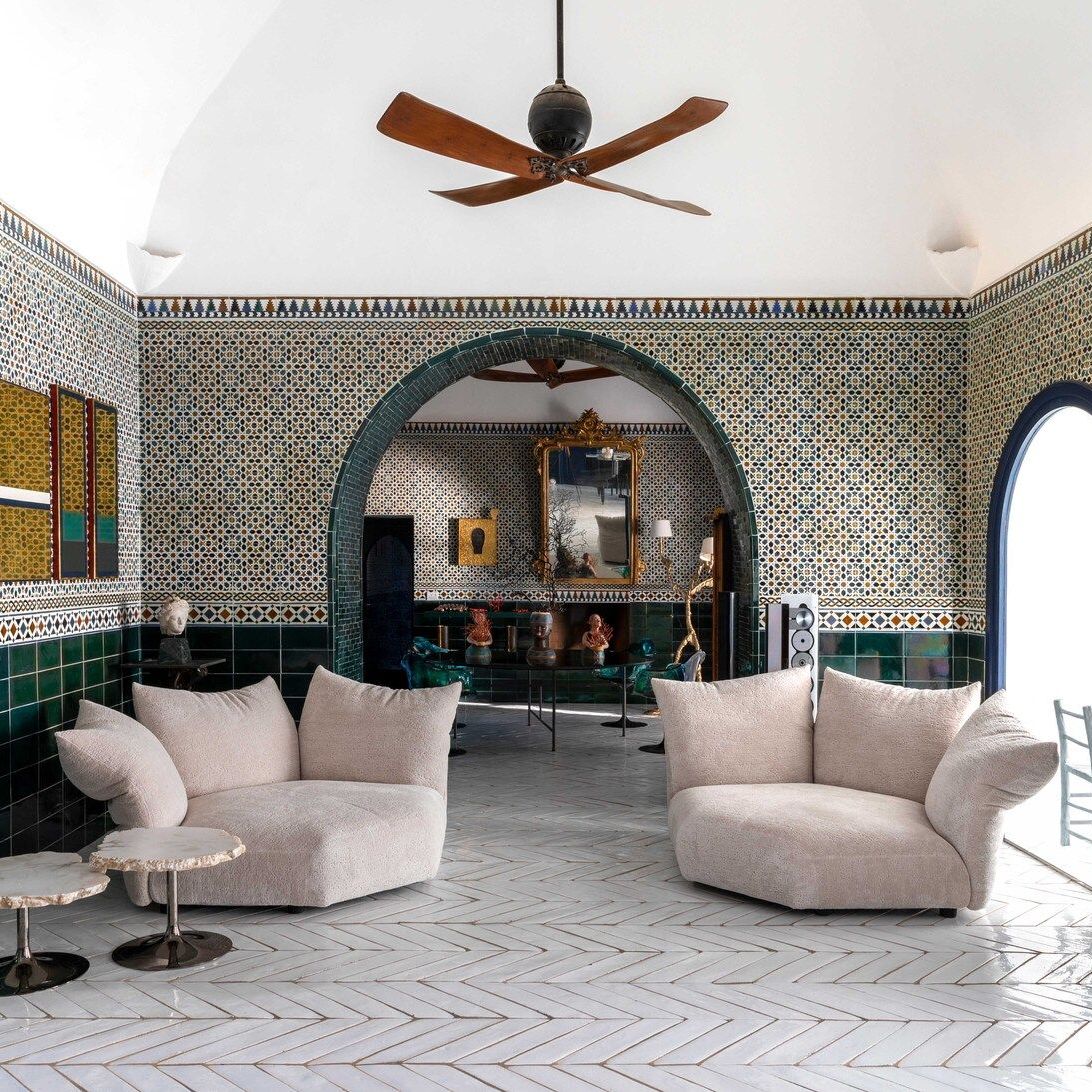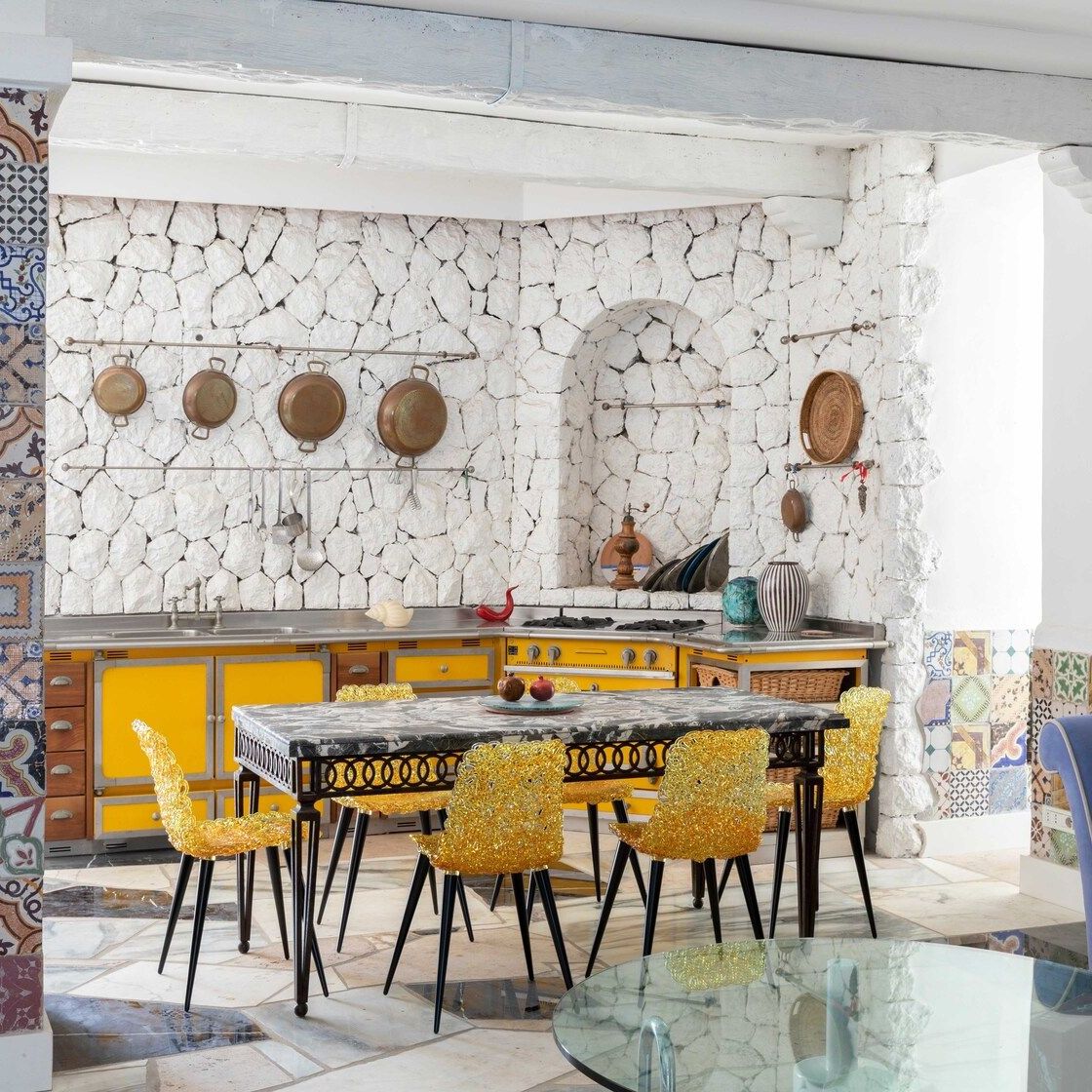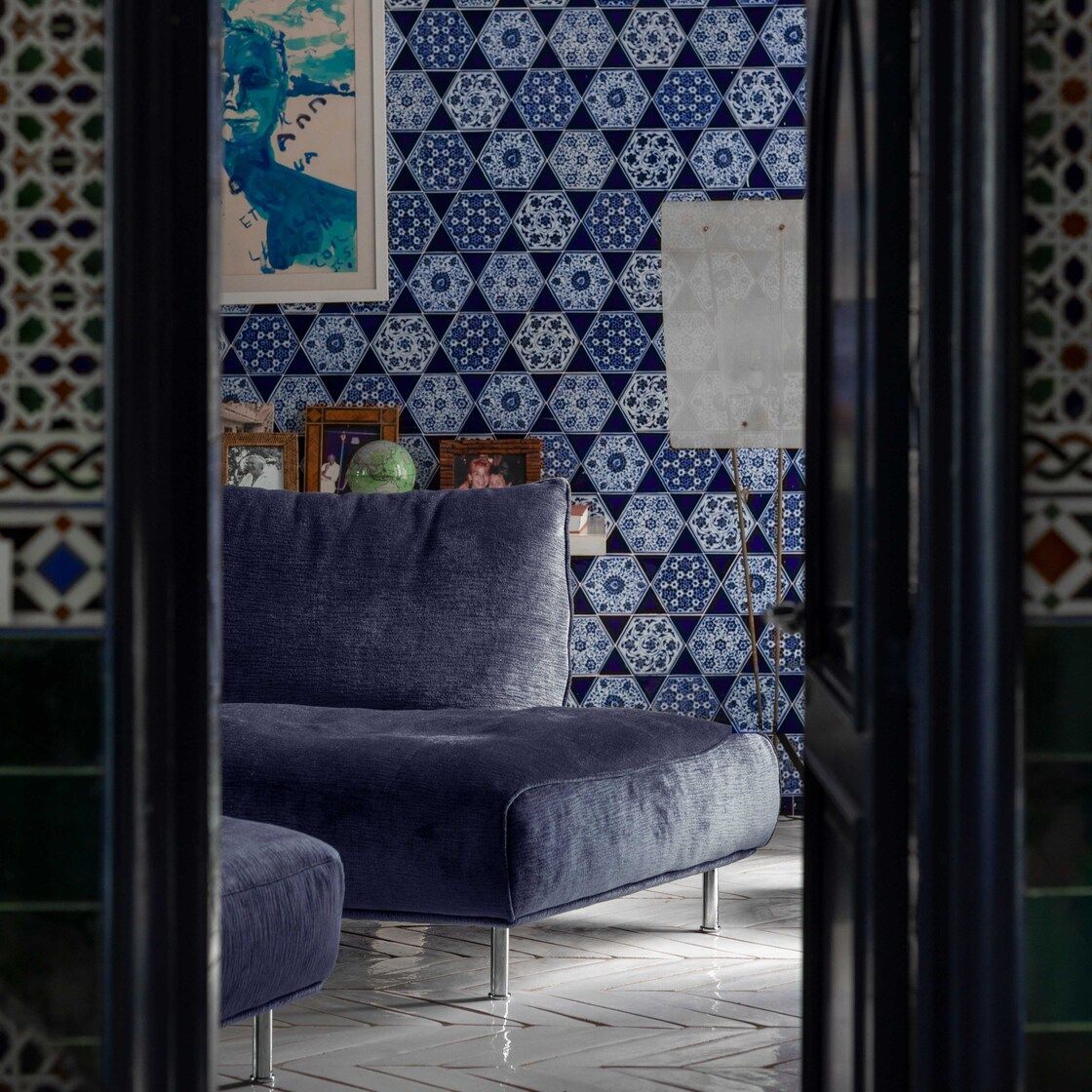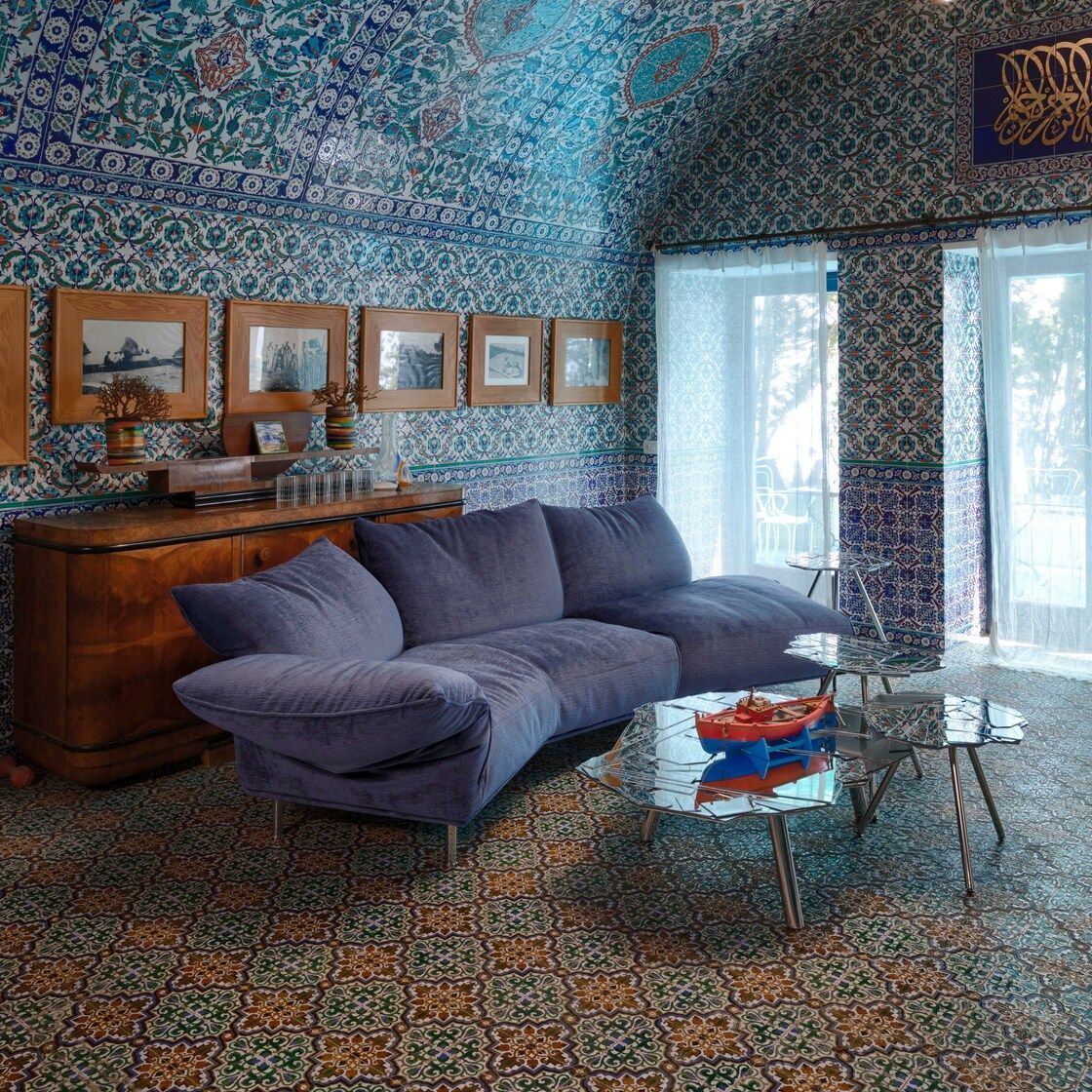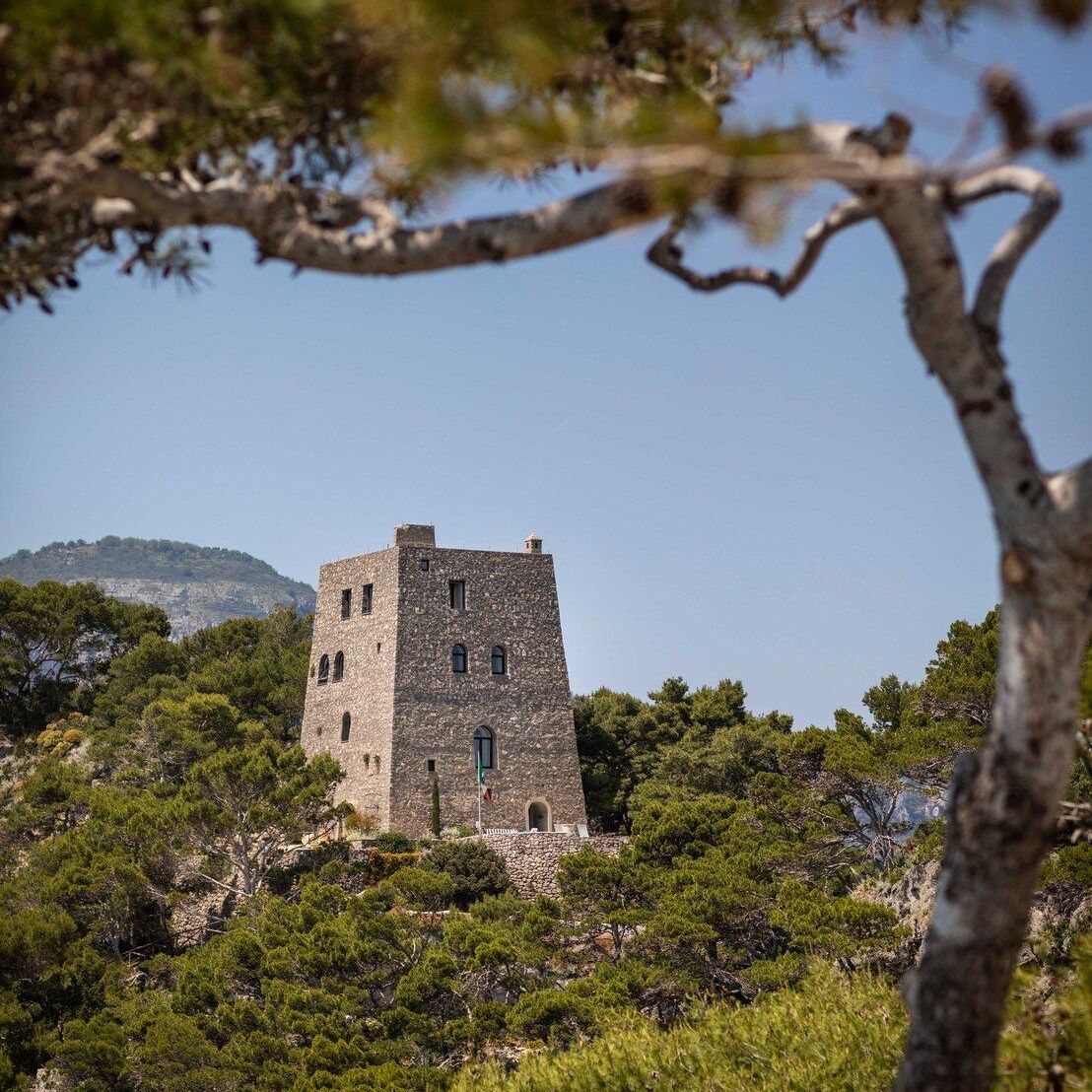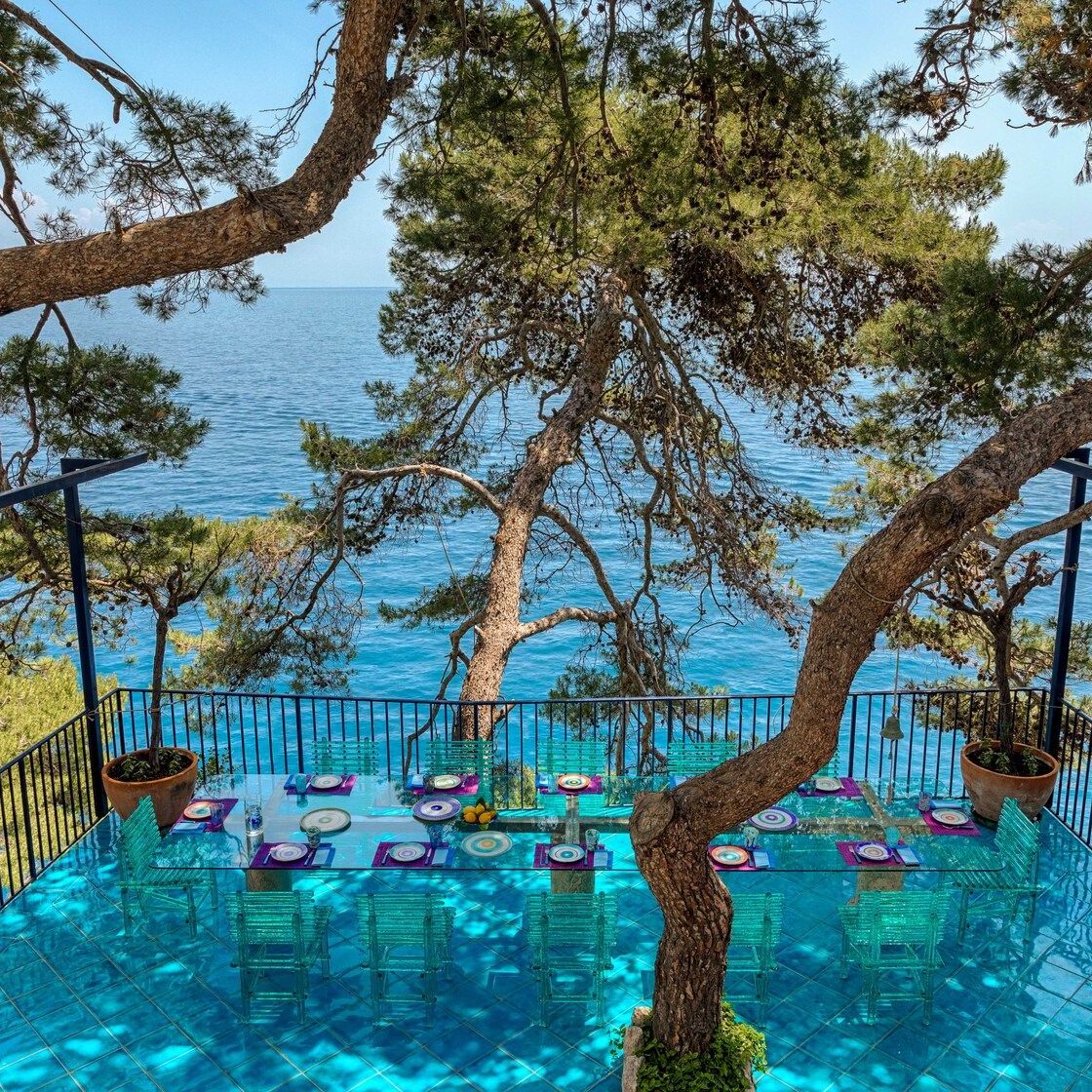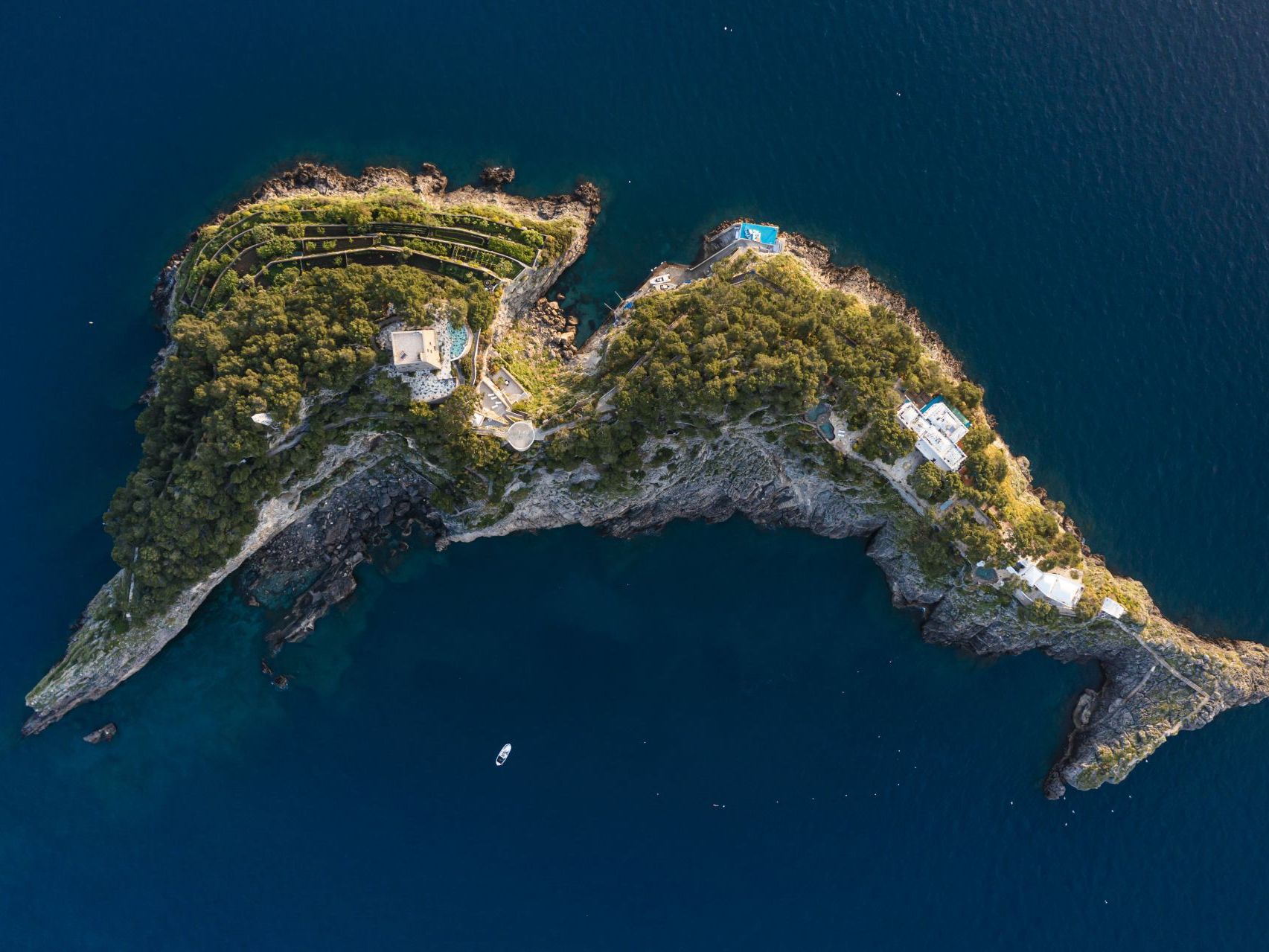
–Р—А—Е–Є–њ–µ–ї–∞–≥ –Ы–Є –У–∞–ї–ї–Є. –Т–Є–і —Б–≤–µ—А—Е—Г –љ–∞ —В—А–Є –Њ—Б—В—А–Њ–≤–∞ - —Б–∞–Љ—Л–є –±–Њ–ї—М—И–Њ–є Gallo Lungo —Б —Б–Є–ї—Г—Н—В–Њ–Љ –і–µ–ї—М—Д–Є–љ–∞, La Rotonda –Є La Castelluccia.
–љ–Њ—П–±—А—П 2022
Laura Arrighi
–Ы–Є –У–∞–ї–ї–Є, –Њ–±–Є—В–µ–ї—М —Б–Є—А–µ–љ
–Р—А—Е–Є–њ–µ–ї–∞–≥, –≥–і–µ –Љ–µ–±–µ–ї—М, –њ—А–Є—А–Њ–і–∞ –Є –Є—Б–Ї—Г—Б—Б—В–≤–Њ —Б—Г—Й–µ—Б—В–≤—Г—О—В –≤–Љ–µ—Б—В–µ
Neverland –і–µ–є—Б—В–≤–Є—В–µ–ї—М–љ–Њ —Б—Г—Й–µ—Б—В–≤—Г–µ—В - —Г –њ–Њ–±–µ—А–µ–ґ—М—П –Я–Њ–Ј–Є—В–∞–љ–Њ, —Б –≤–Є–і–Њ–Љ –љ–∞ –Њ—Б—В—А–Њ–≤ –Ъ–∞–њ—А–Є. –Ч–і–µ—Б—М –ґ–Є–ї–Є –Є–Ј–≤–µ—Б—В–љ—Л–µ —В–∞–љ—Ж–Њ—А—Л, –Њ—З–∞—А–Њ–≤–∞–љ–љ—Л–µ –њ–µ–љ–Є–µ–Љ —Б–Є—А–µ–љ. –Я–Є—Б–∞—В–µ–ї–Є, —Б–њ–ї–µ—В–∞—О—Й–Є–µ –Є—Б—В–Њ—А–Є–Є –Є–Ј –≤–µ—З–љ–Њ—Б—В–Є. –Р—А—Е–Є—В–µ–Ї—В–Њ—А—Л, —Б–Њ–Ј–і–∞—О—Й–Є–µ –њ—А–Є—О—В—Л –і–ї—П –і—Г—И–Є. –Т—Л –≤—А—П–і –ї–Є –≤—Б—В—А–µ—В–Є—В–µ –Є—Е, –њ—А–Њ–є–і—П—Б—М –њ–Њ –Љ–µ—Б—В–љ—Л–Љ –њ–µ—А–µ—Г–ї–Ї–∞–Љ: –Њ–љ–Є –Є–Ј –і—А—Г–≥–Њ–є —Н–њ–Њ—Е–Є, —Е–Њ—В—П –Є—Е —Н–њ–Њ—Е–∞ –љ–Є–Ї–Њ–≥–і–∞ –љ–µ –Ї–Њ–љ—З–∞–ї–∞—Б—М, –Є –њ–Њ—Н—В–Њ–Љ—Г –≤—Л –Њ—Й—Г—Й–∞–µ—В–µ –Є—Е –њ—А–Є—Б—Г—В—Б—В–≤–Є–µ –≤–Њ –≤—Б–µ–Љ, —З—В–Њ –≤—Л –≤–Є–і–Є—В–µ, –і–µ–ї–∞–µ—В–µ –Є –і—Г–Љ–∞–µ—В–µ.
–Ю–±–Є—В–µ–ї—М —Б–Є—А–µ–љ.
–І–µ—А–µ–Ј –њ—А–Њ–ї–Є–≤ –Њ—В –Я–Њ–Ј–Є—В–∞–љ–Њ –љ–∞ –њ—Г—В–Є –Ї –Њ—Б—В—А–Њ–≤—Г –Ъ–∞–њ—А–Є —А–∞—Б–њ–Њ–ї–Њ–ґ–Є–ї—Б—П —Г–љ–Є–Ї–∞–ї—М–љ—Л–є –∞—А—Е–Є–њ–µ–ї–∞–≥ “Li Galli”. –Ю–љ —Б–Њ—Б—В–Њ–Є—В –Є–Ј —В—А–µ—Е –Њ—Б—В—А–Њ–≤–Њ–≤: "Gallo Lungo" - —Б–∞–Љ—Л–є –±–Њ–ї—М—И–Њ–є, –њ–Њ —Д–Њ—А–Љ–µ –љ–∞–њ–Њ–Љ–Є–љ–∞—О—Й–Є–є –і–µ–ї—М—Д–Є–љ–∞, "La Rotonda" –Є "La Castelluccia", –Є–Ј–≤–µ—Б—В–љ—Л–є —В–∞–Ї–ґ–µ –Ї–∞–Ї "Isola dei Briganti", –Є–ї–Є –Њ—Б—В—А–Њ–≤ –њ–Є—А–∞—В–Њ–≤, –Ї–Њ—В–Њ—А—Л–µ –Ї–Њ–≥–і–∞-—В–Њ —В–Њ–ґ–µ –Ј–і–µ—Б—М –ґ–Є–ї–Є. –°–µ–є—З–∞—Б –Љ–∞–є, –Є —П –њ–Њ–і–њ–ї—Л–≤–∞—О –Ї –∞—А—Е–Є–њ–µ–ї–∞–≥—Г. –Ь–Њ–µ–Љ—Г –≤–Ј–Њ—А—Г –Њ—В–Ї—А—Л–≤–∞–µ—В—Б—П –≤–Њ–ї—И–µ–±–љ–Њ–µ –Љ–µ—Б—В–Њ: —Б–Њ–ї–љ–µ—З–љ—Л–є —Б–≤–µ—В —Б–Ї–≤–Њ–Ј—М –Њ–±–ї–∞–Ї–∞ —А–Њ–љ—П–µ—В —Б–≤–Њ–Є —В–µ–љ–Є –љ–∞ —Б–Ї–ї–Њ–љ—Л, —Б–±–µ–≥–∞—О—Й–Є–µ –≤–љ–Є–Ј –Ї –Љ–Њ—А—О, –≤–Њ–ї–љ—Л –њ–ї–µ—Й—Г—В—Б—П –Њ —Б–Ї–∞–ї—Л, –∞ –≥—Г—Б—В—Л–µ –Ї–Њ—А–∞–±–µ–ї—М–љ—Л–µ —Б–Њ—Б–љ—Л –љ–∞ –≤–µ—А—И–Є–љ–µ, —Б–ї–Њ–≤–љ–Њ —Е—А–∞–љ—П—В –≤ —Б–µ–±–µ –Ї–∞–Ї—Г—О-—В–Њ —В–∞–є–љ—Г. –°—А–µ–і—М –±—Г–є—Б—В–≤–∞ —Н—В–Њ–є –і–Є–Ї–Њ–є –Є –µ—Б—В–µ—Б—В–≤–µ–љ–љ–Њ–є –њ—А–Є—А–Њ–і—Л –Љ–Њ–ґ–љ–Њ —А–∞–Ј–≥–ї—П–і–µ—В—М –Љ–µ—Б—В–Њ –і–ї—П –њ—А–Є—З–∞–ї–∞ –Є —Г—Е–Њ–і—П—Й—Г—О –≤–≤–µ—А—Е —В—А–Њ–њ—Г –≤–і–Њ–ї—М –≤—Л—Б–Њ–Ї–Є—Е –Ї–∞–Љ–µ–љ–љ—Л—Е —Б—В–µ–љ. –Ґ–∞–Ї –≤—Л–≥–ї—П–і–Є—В –њ—А–Є–≥–ї–∞—И–µ–љ–Є–µ —Б–Њ–є—В–Є –љ–∞ –±–µ—А–µ–≥. –ѓ –љ–∞—З–Є–љ–∞—О –њ–Њ–љ–Є–Љ–∞—В—М, –њ–Њ—З–µ–Љ—Г —Н—В–Є —В—А–Є –Њ—Б—В—А–Њ–≤–∞ –љ–∞–Ј—Л–≤–∞—О—В –°–Є—А–µ–љ—Г–Ј–Њ–є –Є–ї–Є –Ю–±–Є—В–µ–ї—М—О —Б–Є—А–µ–љ. –Я–µ–љ–Є–µ —Б–Є—А–µ–љ - —Н—В–Њ, –Ї–Њ–љ–µ—З–љ–Њ, –Љ–µ—В–∞—Д–Њ—А–∞, –љ–Њ –Ј–Њ–≤ –Њ—Б—В—А–Њ–≤–∞, –≤–і–Њ—Е–љ–Њ–≤–ї—П—О—Й–Є–є –љ–∞ –њ–Њ–Є—Б–Ї–Є –љ–Њ–≤—Л—Е –≤–њ–µ—З–∞—В–ї–µ–љ–Є–є –Є –Њ—В–Ї—А—Л—В–Є–є, –і–µ–є—Б—В–≤–Є—В–µ–ї—М–љ–Њ –Њ—Й—Г—Й–∞–µ—В—Б—П. –Ь–Є—Д –Њ —Б–Є—А–µ–љ–∞—Е —А–∞—Б—Б–Ї–∞–Ј–∞–љ –У–Њ–Љ–µ—А–Њ–Љ –≤ XII –Ї–љ–Є–≥–µ "–Ю–і–Є—Б—Б–µ–Є". –Ю–і–Є—Б—Б–µ–є —А–∞—Б—Б–Ї–∞–Ј—Л–≤–∞–µ—В —Ж–∞—А—О –Р–ї–Ї–Є–љ–Њ—О, –Ї–∞–Ї, –њ–Њ–ї—Г—З–Є–≤ –Њ—В –¶–Є—А—Ж–µ–Є –њ—А–µ–і—Г–њ—А–µ–ґ–і–µ–љ–Є–µ –Њ –њ—А–µ–і—Б—В–Њ—П—Й–µ–є –≤—Б—В—А–µ—З–µ —Б —А—Г—Б–∞–ї–Ї–∞–Љ–Є, –ґ–Є–≤—Г—Й–Є–Љ–Є –љ–∞ –∞—А—Е–Є–њ–µ–ї–∞–≥–µ, –Є –Њ–± –Њ–њ–∞—Б–љ–Њ—Б—В–Є, –Ї–Њ—В–Њ—А—Г—О —В–∞–Є—В –≤ —Б–µ–±–µ –Є—Е –њ–µ–љ–Є–µ, –Њ–љ —Б—Г–Љ–µ–ї –Є–Ј–±–µ–ґ–∞—В—М –Є—Е –ї–Њ–≤—Г—И–Ї–Є. –•–Њ—В—П –Њ–±—А–∞–Ј —Б–Є—А–µ–љ –≤ –≤–Є–і–µ –і–µ–≤-—А—Л–± –њ—А–Є—Б—Г—В—Б—В–≤—Г–µ—В –≤ –Ф—А–µ–≤–љ–µ–є –У—А–µ—Ж–Є–Є, –≤ –Љ–Є—Д–Њ–ї–Њ–≥–Є–Є –≤—Б—В—А–µ—З–∞–µ—В—Б—П –Є –±–Њ–ї–µ–µ "–Ј–µ–Љ–љ–Њ–є" –≤–∞—А–Є–∞–љ—В —Н—В–Є—Е —Б—Г—Й–µ—Б—В–≤. –Т "–Р—А–≥–Њ–љ–∞–≤—В–Є–Ї–µ" –Р–њ–Њ–ї–ї–Њ–љ–Є—П –†–Њ–і–Є—П –Ю—А—Д–µ–є, –њ—А–Є–±—Л–≤—И–Є–є –Ї –Њ—Б—В—А–Њ–≤—Г —Б–Є—А–µ–љ, —Г–≤–Є–і–µ–ї —Б—Г—Й–µ—Б—В–≤ –≤ –≤–Є–і–µ –і–µ–≤ —Б –њ–µ—В—Г—И–Є–љ—Л–Љ–Є –≥–Њ–ї–Њ–≤–∞–Љ–Є. –°–Њ–±—Б—В–≤–µ–љ–љ–Њ –љ–∞–Ј–≤–∞–љ–Є–µ –∞—А—Е–Є–њ–µ–ї–∞–≥–∞ «Li Galli» –Є –њ–µ—А–µ–≤–Њ–і–Є—В—Б—П —Б –Є—В–∞–ї—М—П–љ—Б–Ї–Њ–≥–Њ –Ї–∞–Ї «–њ–µ—В—Г—Е–Є».
–Ю–±–Є—В–µ–ї—М —В–∞–љ—Ж–∞.
–ѓ –њ–Њ–і–љ–Є–Љ–∞—О—Б—М –≤–≤–µ—А—Е –њ–Њ —В—А–Њ–њ–µ –≤ –Њ–Ї—А—Г–ґ–µ–љ–Є–Є –њ—Л—И–љ–Њ–є, —Г—Е–Њ–ґ–µ–љ–љ–Њ–є –њ—А–Є—А–Њ–і—Л, —Ж–≤–µ—В–Њ–≤ –Є –і–Є–Ї–Њ–є —А–∞—Б—В–Є—В–µ–ї—М–љ–Њ—Б—В–Є, –Ї–Њ—В–Њ—А—Л–µ –њ–Њ—А–∞–ґ–∞—О—В –±—Г–є—Б—В–≤–Њ–Љ –Ї—А–∞—Б–Њ–Ї –Є –∞—А–Њ–Љ–∞—В–Њ–≤. –Т—Л—Б–Њ–Ї–Є–µ –Ї–∞–Љ–µ–љ–љ—Л–µ —Б—В–µ–љ—Л —Г–≤–µ–љ—З–∞–љ—Л –љ–µ–±–Њ–ї—М—И–Є–Љ–Є —Б—В–∞—В—Г—П–Љ–Є - –њ–µ—В—Г—И–Ї–∞–Љ–Є. –ѓ –Ј–∞–Љ–µ—З–∞—О —Б–∞–і–Њ–≤–љ–Є–Ї–Њ–≤ –Є –Љ–µ—Б—В–љ—Л–є –њ–µ—А—Б–Њ–љ–∞–ї. –Ю–љ–Є –њ–Њ–і—Б—В—А–Є–≥–∞—О—В —А–∞—Б—В–µ–љ–Є—П –Є –≤–Њ–Ј–і–µ–ї—Л–≤–∞—О—В –Њ–≥–Њ—А–Њ–і, —З–Є—Б—В—П—В –і–Њ—А–Њ–ґ–Ї–Є. –Ъ–Њ –Љ–љ–µ –љ–∞–≤—Б—В—А–µ—З—Г —Б–њ—Г—Б–Ї–∞–µ—В—Б—П –Љ–Њ–ї–Њ–і–Њ–є —З–µ–ї–Њ–≤–µ–Ї –Є –њ—А–µ–і–ї–∞–≥–∞–µ—В –њ–Њ–њ—А–Њ–±–Њ–≤–∞—В—М —Б–≤–µ–ґ–µ—Б–Њ–±—А–∞–љ–љ—Л–є –Љ–µ–і. –Э–∞ –Њ—Б—В—А–Њ–≤–µ –Ї–Є–њ–Є—В –ґ–Є–Ј–љ—М. –ѓ –њ–Њ–і–љ–Є–Љ–∞—О –≥–Њ–ї–Њ–≤—Г –Є –≤–Є–ґ—Г —Б—В–∞—А—Г—О, –Њ—В—А–µ—Б—В–∞–≤—А–Є—А–Њ–≤–∞–љ–љ—Г—О —Б–∞—А–∞—Ж–Є–љ—Б–Ї—Г—О –±–∞—И–љ—О, –Є –Ї–Њ–≥–і–∞, –љ–∞–Ї–Њ–љ–µ—Ж, —П –і–Њ—Е–Њ–ґ—Г –і–Њ –≤–Є–ї–ї—Л, –њ–Њ—Б—В—А–Њ–µ–љ–љ–Њ–є –љ–∞ —А—Г–Є–љ–∞—Е –і—А–µ–≤–љ–µ—А–Є–Љ—Б–Ї–Є—Е –њ–Њ—Б—В—А–Њ–µ–Ї, —П –Њ—В–Љ–µ—З–∞—О, —З—В–Њ –≤–Ј–≥–ї—П–і —Г–ї–∞–≤–ї–Є–≤–∞–µ—В –Ї–∞–Ї–Є–µ-—В–Њ —Б–ї–µ–і—Л –њ—А–Њ—И–ї–Њ–≥–Њ, –љ–Њ –±—Г–і—В–Њ –±—Л –µ—Б—В—М —З—В–Њ-—В–Њ —Б–Ї—А—Л—В–Њ–µ –Њ—В –≥–ї–∞–Ј, –Ї–∞–Ї –≤–µ—З–љ–∞—П –њ–µ—З–∞—В—М –≤—А–µ–Љ–µ–љ–Є. –£ –≤—Е–Њ–і–∞ –љ–∞ –≤–Є–ї–ї—Г –Љ–µ–љ—П —Б —Г–ї—Л–±–Ї–Њ–є –≤—Б—В—А–µ—З–∞–µ—В –љ—Л–љ–µ—И–љ–Є–є –≤–ї–∞–і–µ–ї–µ—Ж –Ы–Є –У–∞–ї–ї–Є –Ф–ґ–Њ–≤–∞–љ–љ–Є –†—Г—Б—Б–Њ. –Т –±–µ–ї–Њ–Љ –ї—М–љ—П–љ–Њ–Љ –Ї–Њ—Б—В—О–Љ–µ, –±–Њ—Б–Є–Ї–Њ–Љ, –і–µ—А–ґ–∞ –љ–∞ —А—Г–Ї–∞—Е —Б–≤–Њ—О —В–∞–Ї—Б—Г, –Њ–љ —А–∞—Б–њ–∞—Е–Є–≤–∞–µ—В –Њ–±—К—П—В–Є—П, –њ—А–Є–≤–µ—В—Б—В–≤—Г—П –Љ–µ–љ—П. –Х–≥–Њ –≤–Ј–≥–ї—П–і –Љ—П–≥–Њ–Ї, –Ї–∞–Ї –Є –µ–≥–Њ –Љ–∞–љ–µ—А—Л. –Ф–ґ–Њ–≤–∞–љ–љ–Є —Б—З–Є—В–∞–µ—В —Б–µ–±—П –≥–Њ—Б—В–µ–Љ –Њ—Б—В—А–Њ–≤–∞, –Ї–Њ—В–Њ—А–Њ–Љ—Г –≤—Л–њ–∞–ї–∞ —З–µ—Б—В—М –ґ–Є—В—М –Ј–і–µ—Б—М –Є –Ј–∞–±–Њ—В–Є—В—М—Б—П –Њ –љ–µ–Љ. –Я–Њ—Б—В–µ–њ–µ–љ–љ–Њ –≤—Л—Е–Њ–і–Є—В —Б–Њ–ї–љ—Ж–µ, –Є —П –Њ—В–њ—А–∞–≤–ї—П—О—Б—М –Њ—В–Ї—А—Л–≤–∞—В—М –і–ї—П —Б–µ–±—П –Ы–Є –У–∞–ї–ї–Є –≤–Љ–µ—Б—В–µ —Б –Ф–ґ–Њ–≤–∞–љ–љ–Є –Є –Я—М–µ—В—А–Њ, –љ—Л–љ–µ—И–љ–Є–Љ "—Е—А–∞–љ–Є—В–µ–ї–µ–Љ", –Ї–Њ—В–Њ—А—Л–є –Ј–∞–±–Њ—В–Є—В—Б—П –Њ —Б–Њ–і–µ—А–ґ–∞–љ–Є–Є –∞—А—Е–Є–њ–µ–ї–∞–≥–∞. –Ю–љ–Є –њ–Њ–≤–µ–і–∞–ї–Є –Љ–љ–µ –Є—Б—В–Њ—А–Є—О —З–µ–ї–Њ–≤–µ–Ї–∞, –њ–ї–µ–љ–µ–љ–љ–Њ–≥–Њ –Ї—А–∞—Б–Њ—В–Њ–є –Њ—Б—В—А–Њ–≤–∞, –Ї–Њ—В–Њ—А—Л–є –љ–µ —Б–Љ–Њ–≥ –њ–Њ–Ї–Є–љ—Г—В—М –µ–≥–Њ, –µ–і–≤–∞ –≤—Л—Б–∞–і–Є–≤—И–Є—Б—М –љ–∞ –±–µ—А–µ–≥. –У–ї–∞–≤–љ–∞—П –≤–Є–ї–ї–∞ –±—Л–ї–∞ –њ–Њ—Б—В—А–Њ–µ–љ–∞ –≤ 20-—Е –≥–Њ–і–∞—Е –•–• –≤–µ–Ї–∞, –Ї–Њ–≥–і–∞ –њ–Њ –њ—А–Є–≥–ї–∞—И–µ–љ–Є—О —А—Г—Б—Б–Ї–Њ–≥–Њ –њ–Є—Б–∞—В–µ–ї—П –Ь–Є—Е–∞–Є–ї–∞ –Э–Є–Ї–Њ–ї–∞–µ–≤–Є—З–∞ –°–µ–Љ–µ–љ–Њ–≤–∞ —А—Г—Б—Б–Ї–Є–є –±–∞–ї–µ—В–Љ–µ–є—Б—В–µ—А –Є —Е–Њ—А–µ–Њ–≥—А–∞—Д –Ы–µ–Њ–љ–Є–і –§–µ–і–Њ—А–Њ–≤–Є—З –Ь—П—Б–Є–љ (–Ы–µ–Њ–љ–Є–і –Ь–∞—Б—Б–Є–љ–µ) –њ—А–Є–µ—Е–∞–ї –≤ –Ш—В–∞–ї–Є—О –≤ —Б–Њ–њ—А–Њ–≤–Њ–ґ–і–µ–љ–Є–Є –Я–Є–Ї–∞—Б—Б–Њ, –Ї—Г–њ–Є–ї –Њ—Б—В—А–Њ–≤ –Є –њ–Њ—Б–µ–ї–Є–ї—Б—П –Ј–і–µ—Б—М –љ–∞–≤—Б–µ–≥–і–∞. –Ю–љ –Ј–∞–і—Г–Љ–∞–ї —Б–і–µ–ї–∞—В—М –Ы–Є –У–∞–ї–ї–Є —Ж–µ–љ—В—А–Њ–Љ —Е—Г–і–Њ–ґ–µ—Б—В–≤–µ–љ–љ–Њ–є –ґ–Є–Ј–љ–Є. –Т —В–Њ –≤—А–µ–Љ—П –љ–∞ –Њ—Б—В—А–Њ–≤–µ –љ–∞—Е–Њ–і–Є–ї–Є—Б—М —А–∞–Ј–≤–∞–ї–Є–љ—Л —Б–∞—А–∞—Ж–Є–љ—Б–Ї–Њ–є –±–∞—И–љ–Є, –і—А–µ–≤–љ–µ—А–Є–Љ—Б–Ї–Њ–є –≤–Є–ї–ї—Л, –≤–Њ–і–Њ—Е—А–∞–љ–Є–ї–Є—Й–∞ –Є –њ—А–Є—З–∞–ї–∞, –∞ —В–∞–Ї–ґ–µ —Б—В–∞—А–∞—П –њ–Њ—Б—В—А–Њ–є–Ї–∞ –≤ –≤–µ—А—Е–љ–µ–є —З–∞—Б—В–Є –љ–µ–±–Њ–ї—М—И–Њ–є –±—Г—Е—В—Л, –Њ–±—А–∞—Й–µ–љ–љ–Њ–є –Ї –Љ–∞—В–µ—А–Є–Ї—Г. –Ы–µ—В–Њ–Љ 1924 –≥. –љ–∞—З–∞–ї–∞—Б—М —Б–µ—А–Є—П –ї–∞–љ–і—И–∞—Д—В–љ—Л—Е –Є –∞—А—Е–Є—В–µ–Ї—В—Г—А–љ—Л—Е —А–∞–±–Њ—В. –Т –Ї–љ–Є–≥–µ "The Siren Isles, Li Galli" –†–Њ–Љ–Њ–ї–Њ –≠—А–Ї–Њ–ї–Є–љ–Њ —А–∞—Б—Б–Ї–∞–Ј—Л–≤–∞–µ—В, —З—В–Њ –і–ї—П —А–∞–Ј—А–∞–±–Њ—В–Ї–Є –њ—А–Њ–µ–Ї—В–∞ –≤–Є–ї–ї—Л –Ь—П—Б–Є–љ –Њ–±—А–∞—В–Є–ї—Б—П –Ї —Б–≤–Њ–µ–Љ—Г –і—А—Г–≥—Г –Є –∞—А—Е–Є—В–µ–Ї—В–Њ—А—Г –Ы–µ –Ъ–Њ—А–±—О–Ј—М–µ, –Ї–Њ—В–Њ—А—Л–є –њ—А–Є–µ—Е–∞–ї –њ–Њ–≥–Њ—Б—В–Є—В—М –≤ –Я–Њ–Ј–Є—В–∞–љ–Њ.
–Я–Њ—Е–Њ–ґ–µ, —Б—Г—Й–µ—Б—В–≤—Г–µ—В —Б–≤—П–Ј—М –Љ–µ–ґ–і—Г –Њ–њ—А–µ–і–µ–ї–µ–љ–љ—Л–Љ —В–Є–њ–Њ–Љ –Њ—Б—В—А–Њ–≤–Њ–≤ –Є –Љ–µ—З—В–∞–Љ–Є. –Р –Љ–Њ–ґ–µ—В –±—Л—В—М, –і–µ–ї–Њ –≤ —В–Њ–Љ, —З—В–Њ –Њ—Б—В—А–Њ–≤–∞ —В–∞–Ї–Њ–≥–Њ —А–Њ–і–∞ –њ—А–Є—В—П–≥–Є–≤–∞—О—В –Љ–µ—З—В–∞—В–µ–ї–µ–є.
–Ы–µ –Ъ–Њ—А–±—О–Ј—М–µ —В–∞–Ї–ґ–µ –њ–Њ—Б–µ—В–Є–ї –Ъ–∞–њ—А–Є –Є –±—Л–ї –Њ—З–∞—А–Њ–≤–∞–љ –µ–≥–Њ —Б–њ–Њ–љ—В–∞–љ–љ–Њ–є –∞—А—Е–Є—В–µ–Ї—В—Г—А–Њ–є. –≠—В–Њ–Љ—Г –Њ–љ –њ–Њ—Б–≤—П—В–Є–ї —Б—В–∞—В—М—О –≤ –ґ—Г—А–љ–∞–ї–µ "Domus" –≤ –Њ–Ї—В—П–±—А–µ 1937 –≥., –≤ –Ї–Њ—В–Њ—А–Њ–є –Њ–±—К—П—Б–љ–Є–ї, –њ–Њ—З–µ–Љ—Г –Є–Ј –≤—Б–µ—Е –Њ–њ—А–µ–і–µ–ї–µ–љ–Є–є –∞—А—Е–Є—В–µ–Ї—В—Г—А—Л, –љ–∞–Є–±–Њ–ї–µ–µ –≤—Л—А–∞–Ј–Є—В–µ–ї—М–љ—Л–Љ –і–ї—П –љ–µ–≥–Њ —П–≤–ї—П–µ—В—Б—П: "–°—В—А–Њ–Є—В–µ–ї—М—Б—В–≤–Њ —Г–±–µ–ґ–Є—Й–∞. –Т–µ–і—М –µ—Б–ї–Є —В–µ–ї–Њ, —Б–µ—А–і—Ж–µ –Є –Љ—Л—Б–ї–Є –≤ –±–µ–Ј–Њ–њ–∞—Б–љ–Њ—Б—В–Є, —В–Њ –љ–Є—З—В–Њ –љ–µ –Љ–Њ–ґ–µ—В –Њ–≥—А–∞–љ–Є—З–Є—В—М –Є—Е –њ–Њ–ї–µ—В: –±–µ—Б–Ї–Њ–љ–µ—З–љ–∞—П —Д–∞–љ—В–∞–Ј–Є—П. –Ю–љ–∞ –Љ–Њ–ґ–µ—В —Б—В–∞—В—М —З—Г–і–µ—Б–љ–Њ –Њ—А–Ї–µ—Б—В—А–Њ–≤–∞–љ–љ–Њ–є —Б–Є–Љ—Д–Њ–љ–Є–µ–є, –Ї–Њ—В–Њ—А–∞—П –Љ–Њ–ґ–µ—В –Њ—Б—В–∞—В—М—Б—П —Б–і–µ—А–ґ–∞–љ–љ–Њ–є –њ–Њ —Д–Њ—А–Љ–µ –Є–ї–Є –Њ–±—А–µ—Б—В–Є –≥–Њ–ї–Њ—Б —З–Є—Б—В–Њ–є –њ–µ—Б–љ–Є. [...] –Я—А–Њ–Є–Ј–≤–µ–і–µ–љ–Є—П –љ–∞—А–Њ–і–љ–Њ–≥–Њ —В–≤–Њ—А—З–µ—Б—В–≤–∞ –љ–µ—В –љ–µ–Њ–±—Е–Њ–і–Є–Љ–Њ—Б—В–Є –Њ–±—К—П—Б–љ—П—В—М: –Њ–љ–Є –≥–Њ–≤–Њ—А—П—В —Б –љ–∞–Љ–Є. [...] –Ф–Њ–Љ - —Н—В–Њ –Њ—В—А–∞–ґ–µ–љ–Є–µ –і—Г—Е–∞. –Ю–љ - —В–Њ, —З–µ–Љ –Љ—Л —П–≤–ї—П–µ–Љ—Б—П –Є–ї–Є —Е–Њ—В–Є–Љ –±—Л—В—М. [...] –Ю–љ —А–Њ–ґ–і–∞–µ—В—Б—П –Є–Ј –ї—Г—З—И–Є—Е –њ—А–Њ—П–≤–ї–µ–љ–Є–є –≤–µ—Й–µ–є, –њ—А–Є—А–Њ–і—Л –Є —З–µ–ї–Њ–≤–µ–Ї–∞". –Т–Њ—Б—Е–≤–∞–ї—П—П "—З–Є—Б—В—Г—О", –њ—А–Њ—Б—В—Г—О, —Б–њ–Њ–љ—В–∞–љ–љ—Г—О –∞—А—Е–Є—В–µ–Ї—В—Г—А—Г, –Ы–µ –Ъ–Њ—А–±—О–Ј—М–µ –≤ —Б–≤–Њ–µ–Љ —В–µ–Ї—Б—В–µ –њ–Њ–і—З–µ—А–Ї–Є–≤–∞–µ—В —В–µ –∞—Б–њ–µ–Ї—В—Л, –Ї–Њ—В–Њ—А—Л–µ –Љ—Л —Г–Ј–љ–∞–µ–Љ –Є –≤ –∞—А—Е–Є—В–µ–Ї—В—Г—А–µ –Ы–Є –У–∞–ї–ї–Є: "–∞—А—Е–Є—В–µ–Ї—В—Г—А–љ–Њ–µ –њ—А–Њ–Є–Ј–≤–µ–і–µ–љ–Є–µ –Є—Б–Ї—Г—Б—Б—В–≤–∞ –Ј–∞—А–Њ–і–Є–ї–Њ—Б—М –љ–∞ —В–Њ–Љ —Б–Ї–ї–Њ–љ–µ –Њ—Б—В—А–Њ–≤–∞, –≥–і–µ —Г–љ–Є–Ї–∞–ї—М–љ—Л–є –њ—А–Є—А–Њ–і–љ—Л–є –ї–∞–љ–і—И–∞—Д—В —Б–Њ—З–µ—В–∞–µ—В—Б—П —Б “—А—Г–Ї–Њ—В–≤–Њ—А–љ—Л–Љ”, —Б–Њ–Ј–і–∞–≤–∞–≤—И–Є–Љ—Б—П –≤–µ–Ї–∞–Љ–Є. –Т–Њ–Њ–і—Г—И–µ–≤–ї–µ–љ–љ—Л–є —Н—В–Є–Љ –і—Г—Е–Њ–Љ, –Ь—П—Б–Є–љ —Г—З–∞—Б—В–≤–Њ–≤–∞–ї –≤ —Б—В—А–Њ–Є—В–µ–ї—М—Б—В–≤–µ –Є —А–µ—Б—В–∞–≤—А–∞—Ж–Є–Є. –Я–µ—А–≤—Л–Љ –і–µ–ї–Њ–Љ –Ь—П—Б–Є–љ –Њ—В—А–µ—Б—В–∞–≤—А–Є—А–Њ–≤–∞–ї —Б–∞—А–∞—Ж–Є–љ—Б–Ї—Г—О —Б—В–Њ—А–Њ–ґ–µ–≤—Г—О –±–∞—И–љ—О. –Ю–љ–∞ —Б—В–∞–ї–∞ –µ–≥–Њ —А–µ–Ј–Є–і–µ–љ—Ж–Є–µ–є —Б –±–Њ–ї—М—И–Є–Љ –±–∞–ї–µ—В–љ—Л–Љ –Ј–∞–ї–Њ–Љ –љ–∞ –≤—В–Њ—А–Њ–Љ —Н—В–∞–ґ–µ. –≠—В–Њ –њ–µ—А–≤–Њ–µ –Ј–і–∞–љ–Є–µ, –≤ –Ї–Њ—В–Њ—А–Њ–µ —П –≤—Е–Њ–ґ—Г. –Ш–і—Г –њ–Њ –њ–∞—А–Ї–µ—В—Г –Є–Ј —Б–Є–±–Є—А—Б–Ї–Њ–є —Б–Њ—Б–љ—Л, –Ї–Њ—В–Њ—А—Л–є –њ–Њ–Љ–љ–Є—В —И–∞–≥–Є –≤–µ–ї–Є–Ї–Є—Е —В–∞–љ—Ж–Њ—А–Њ–≤ –њ—А–Њ—И–ї–Њ–≥–Њ. –Ч–і–µ—Б—М –ґ–µ, –≤ –Љ–µ–Ј–Њ–љ–Є–љ–µ, —А–∞–Ј–Љ–µ—Й–µ–љ—Л –Є–љ—Б—В—А—Г–Љ–µ–љ—В—Л –і–ї—П –Љ—Г–Ј—Л–Ї–∞–ї—М–љ–Њ–≥–Њ –Ї–≤–∞—А—В–µ—В–∞: –±–∞—А–∞–±–∞–љ—Л - –њ–Њ–і–∞—А–Њ–Ї –Ґ—Г–ї–ї–Є–Њ –Ф–µ –Я–Є—Б–Ї–Њ–њ–Њ. –Э–∞ —Б—В–µ–љ–∞—Е –≤–Є—Б—П—В —Б—В–∞—А—Л–µ —Д–Њ—В–Њ–≥—А–∞—Д–Є–Є. –Т —Н—В–Њ–є —В–Є—И–Є–љ–µ –ї—О–±—Л–µ —И–∞–≥–Є –Є —Б–ї–Њ–≤–∞ —Б–ї–Њ–≤–љ–Њ –Њ—В–Ј—Л–≤–∞—О—В—Б—П —Н—Е–Њ–Љ —В–Њ–≥–Њ –≤—А–µ–Љ–µ–љ–Є. –Ъ–Њ–Љ–љ–∞—В—Л –≤–µ—А—Е–љ–Є—Е —Н—В–∞–ґ–µ–є –≤—Л–і–µ—А–ґ–∞–љ—Л –≤ –Њ—В—В–µ–љ–Ї–∞—Е –Љ–Њ—А—П –Є —Б–Њ–ї–љ—Ж–∞. –Ю—В–Ї—А—Л—В–∞—П –Ї—Г—Е–љ—П –њ–µ—А–≤–Њ–≥–Њ —Н—В–∞–ґ–∞ –Њ—В–і–µ–ї–∞–љ–∞ –±–µ–ї—Л–Љ –Ї–∞–Љ–љ–µ–Љ –Є —П–љ—В–∞—А–љ–Њ–є –Љ–∞–є–Њ–ї–Є–Ї–Њ–є. –Ш–Љ–µ–љ–љ–Њ –Ј–і–µ—Б—М –њ—А–Њ–≤–Њ–і–Є–ї–Є —Б–≤–Њ–Є –≤–µ—З–µ—А–∞ –∞—А—В–Є—Б—В—Л –±–∞–ї–µ—В–∞. –Ч–і–µ—Б—М –Љ–љ–Њ–ґ–µ—Б—В–≤–Њ –і–µ–Ї–Њ—А–∞—В–Є–≤–љ—Л—Е –і–µ—В–∞–ї–µ–є –Є –∞—А—В–Є—Б—В–Є—З–љ—Л—Е –њ—А–µ–і–Љ–µ—В–Њ–≤ –Љ–µ–±–µ–ї–Є, –љ–∞–њ—А–Є–Љ–µ—А, —Б—В—Г–ї—М—П Gina. –С—Г–і—В–Њ —Б–њ–ї–µ—В–µ–љ–љ—Л–µ –Є–Ј –±–µ—Б–Ї–Њ–љ–µ—З–љ–Њ–≥–Њ –Ј–Њ–ї–Њ—В–Њ–≥–Њ –Ї—А—Г–ґ–µ–≤–∞, –Њ–љ–Є –њ—А–Є–і–∞—О—В –њ—А–Њ—Б—В—А–∞–љ—Б—В–≤—Г –Є–Ј—П—Й–µ—Б—В–≤–Њ –Є –і–Є–љ–∞–Љ–Є–Ї—Г. –Ь—П—Б–Є–љ –њ–Њ—Б—В—А–Њ–Є–ї —В–∞–Ї–ґ–µ —В–µ–∞—В—А –њ–Њ–і –Њ—В–Ї—А—Л—В—Л–Љ –љ–µ–±–Њ–Љ, –Ї–Њ—В–Њ—А—Л–є –Ї —Б–Њ–ґ–∞–ї–µ–љ–Є—О –±—Л–ї —А–∞–Ј—А—Г—И–µ–љ —Б–Є–ї—М–љ—Л–Љ –Љ–Њ—А—Б–Ї–Є–Љ —И—В–Њ—А–Љ–Њ–Љ –≤ —Б–µ—А–µ–і–Є–љ–µ 1960-—Е –≥–Њ–і–Њ–≤.
–Х–≥–Њ –Є–і–µ—П –Ј–∞–Ї–ї—О—З–∞–ї–∞—Б—М –≤ —В–Њ–Љ, —З—В–Њ–±—Л –њ—А–µ–≤—А–∞—В–Є—В—М Li Galli –≤ –Љ–µ–ґ–і—Г–љ–∞—А–Њ–і–љ—Л–є –∞—А—В-—Ж–µ–љ—В—А, –≥–і–µ –≤–Љ–µ—Б—В–µ —Б–Њ–±–Є—А–∞—О—В—Б—П –Љ–Њ–ї–Њ–і—Л–µ —Е—Г–і–Њ–ґ–љ–Є–Ї–Є, –Ї–Њ–Љ–њ–Њ–Ј–Є—В–Њ—А—Л, –њ–Є—Б–∞—В–µ–ї–Є, –∞—А—В–Є—Б—В—Л –±–∞–ї–µ—В–∞ –Є —Е–Њ—А–µ–Њ–≥—А–∞—Д—Л, —З—В–Њ–±—Л –Њ–±–Љ–µ–љ–Є–≤–∞—В—М—Б—П –Є–і–µ—П–Љ–Є –Є —Б–Њ–Ј–і–∞–≤–∞—В—М –љ–Њ–≤—Л–µ —А–∞–±–Њ—В—Л. –Ш –≤–Њ—В, —Б–њ—Г—Б—В—П –љ–µ—Б–Ї–Њ–ї—М–Ї–Њ –ї–µ—В —П –Љ–Њ–≥—Г –љ–∞–±–ї—О–і–∞—В—М –≤–Њ–њ–ї–Њ—Й–µ–љ–Є–µ —Н—В–Њ–є –Љ—Л—Б–ї–Є –≤ –Є–љ–Њ–Љ “–≤–Є–і–µ –Є—Б–Ї—Г—Б—Б—В–≤–∞”. –Ъ–Њ–≥–і–∞ —Б–Њ–ї–љ—Ж–µ —Г–ґ–µ –≤—Л—Б–Њ–Ї–Њ, –Ї –Њ—Б—В—А–Њ–≤—Г –њ—А–Є–њ–ї—Л–≤–∞—О—В –љ–µ—Б–Ї–Њ–ї—М–Ї–Њ —П—Е—В: –Ј–≤—Г—З–Є—В –Љ—Г–Ј—Л–Ї–∞, —В—Г—А–Є—Б—В—Л –Ї—Г–њ–∞—О—В—Б—П, —А–∞–Ј–≤–ї–µ–Ї–∞—О—В—Б—П, –Є –≤–Њ—В —П –≤–Є–ґ—Г, –Ї–∞–Ї –Њ–љ–Є –Њ—В–њ–ї—Л–≤–∞—О—В. –°–љ–Њ–≤–∞ –љ–∞—Б—В—Г–њ–∞–µ—В –њ—А–Њ–љ–Ј–Є—В–µ–ї—М–љ–∞—П —В–Є—И–Є–љ–∞, –Ї–Њ—В–Њ—А—Г—О –љ–∞—А—Г—И–∞–µ—В –ї–Є—И—М –њ–µ–љ–Є–µ –њ—В–Є—Ж. –ѓ —Б–Љ–Њ—В—А—О –≤–љ–Є–Ј —Б–Њ —Б–Ї–ї–Њ–љ–∞, —Г –Љ–µ–љ—П –љ–µ–Љ–љ–Њ–≥–Њ –Ї—А—Г–ґ–Є—В—Б—П –≥–Њ–ї–Њ–≤–∞, –Є —П –Љ–Њ–≥—Г —А–∞–Ј–ї–Є—З–Є—В—М –Ї–∞–Љ–µ–љ–Є—Б—В–Њ–µ –Љ–Њ—А—Б–Ї–Њ–µ –і–љ–Њ —А—П–і–Њ–Љ —Б–Њ —Б–Ї–∞–ї–∞–Љ–Є, –і–∞–ї—М—И–µ - —В–Њ–ї—М–Ї–Њ —Б–Є–љ–µ–≤–∞ –≥–ї—Г–±–Њ–Ї–Є—Е –≤–Њ–і. –Ш–і—П –њ–Њ —В—А–Њ–њ–Є–љ–Ї–µ, —П –≤—Б—В—А–µ—З–∞—О –µ—Й–µ –і–≤–∞ –љ–µ–±–Њ–ї—М—И–Є—Е —Б—В—А–Њ–µ–љ–Є—П, –≤—Л—Б–µ—З–µ–љ–љ—Л—Е –≤ —Б–Ї–∞–ї–∞—Е. –≠—В–Њ –љ–µ–±–Њ–ї—М—И–Є–µ –Ї–Њ–Љ–љ–∞—В—Л —Б –±–µ–ї—Л–Љ–Є –Ї—А–Њ–≤–∞—В—П–Љ–Є —Б –±–∞–ї–і–∞—Е–Є–љ–Њ–Љ, –±–ї–µ—Б—В—П—Й–µ–є –Љ–∞–є–Њ–ї–Є–Ї–Њ–≤–Њ–є –њ–ї–Є—В–Ї–Њ–є Vietri –љ–∞ –њ–Њ–ї—Г, –Є–Ј—Л—Б–Ї–∞–љ–љ—Л–Љ–Є –і–µ—В–∞–ї—П–Љ–Є –Є—Б–Ї—Г—Б—Б—В–≤–∞, –Љ–µ–±–µ–ї–Є –Є –і–µ–Ї–Њ—А–∞. –Ш–Ј –Ї–∞–ґ–і–Њ–є –Њ—В–Ї—А—Л–≤–∞–µ—В—Б—П —Б–≤–Њ–є –≤–Є–і, –Њ–±—А–∞–Љ–ї—П—О—Й–Є–є —З–∞—Б—В—М –њ–µ–є–Ј–∞–ґ–∞: –њ—А–Њ–Є–Ј–≤–µ–і–µ–љ–Є–µ –Є—Б–Ї—Г—Б—Б—В–≤–∞ –і–ї—П —Б–Њ–Ј–µ—А—Ж–∞–љ–Є—П. –Ф–Њ–є–і—П –і–Њ –≥–ї–∞–≤–љ–Њ–є –≤–Є–ї–ї—Л, —П –≤ –Љ—Л—Б–ї—П—Е –≤–љ–Њ–≤—М —Б–Њ–≤–µ—А—И–∞—О –µ—Й–µ –Њ–і–Є–љ –њ—А—Л–ґ–Њ–Ї –≤ –Є—Б—В–Њ—А–Є—О. –Я–Њ—Б–ї–µ —Б–Љ–µ—А—В–Є –Ь—П—Б–Є–љ–∞ –≤ 1989 –≥–Њ–і—Г –∞—А—Е–Є–њ–µ–ї–∞–≥ –њ–µ—А–µ—И–µ–ї –≤ —Б–Њ–±—Б—В–≤–µ–љ–љ–Њ—Б—В—М –†—Г–і–Њ–ї—М—Д–∞ –Э—Г—А–Є–µ–≤–∞. –Р—А—В–Є—Б—В –±–∞–ї–µ—В–∞ –Є–Ј–Љ–µ–љ–Є–ї –і–Є–Ј–∞–є–љ –≤–Є–ї–ї—Л, —Г–Ї—А–∞—Б–Є–≤ –µ–µ –љ–µ–≤–µ—А–Њ—П—В–љ–Њ–є –Ї–Њ–ї–ї–µ–Ї—Ж–Є–µ–є –Њ—Б–Љ–∞–љ—Б–Ї–Њ–є –Љ–∞–є–Њ–ї–Є–Ї–Є, –Ї–Њ—В–Њ—А—Г—О –Љ—Л –Љ–Њ–ґ–µ–Љ –Њ—Ж–µ–љ–Є—В—М –Є —Б–µ–≥–Њ–і–љ—П. –Т—Б–µ –Ї–Њ–Љ–љ–∞—В—Л –±—Л–ї–Є —Г–Ї—А–∞—И–µ–љ—Л –Ї–Є–ї–Є–Љ–∞–Љ–Є –Є —Б–≤–µ—В–Є–ї—М–љ–Є–Ї–∞–Љ–Є —А—Г—З–љ–Њ–є —А–∞–±–Њ—В—Л. –Я—М–µ—В—А–Њ —А–∞—Б—Б–Ї–∞–Ј—Л–≤–∞–µ—В, —З—В–Њ –њ–Њ—Б–ї–µ —Б–Љ–µ—А—В–Є —В–∞–љ—Ж–Њ—А–∞, –Ї–Њ–≥–і–∞ –Њ—Б—В—А–Њ–≤ –њ–µ—А–µ–ґ–Є–≤–∞–ї "—В–µ–Љ–љ—Л–µ" –≤—А–µ–Љ–µ–љ–∞, —З–∞—Б—В—М –Ї–µ—А–∞–Љ–Є–Ї–Є –±—Л–ї–∞ —Г–Ї—А–∞–і–µ–љ–∞. –Ю–і–љ–∞–Ї–Њ –±–Њ–ї—М—И—Г—О —З–∞—Б—В—М –і–µ–Ї–Њ—А–∞ –≤—Б–µ –ґ–µ —Г–і–∞–ї–Њ—Б—М —Б–Њ—Е—А–∞–љ–Є—В—М “—Е—А–∞–љ–Є—В–µ–ї—О” –Њ—Б—В—А–Њ–≤–∞, –Ї–Њ—В–Њ—А—Л–є –Ј–∞–±–∞—А—А–Є–Ї–∞–і–Є—А–Њ–≤–∞–ї—Б—П –≤–љ—Г—В—А–Є –≥–ї–∞–≤–љ–Њ–є –≤–Є–ї–ї—Л, —З—В–Њ–±—Л –Ј–∞—Й–Є—В–Є—В—М –µ–µ. “–Т–Њ –≤—Б–µ –≤—А–µ–Љ–µ–љ–∞ “—Е—А–∞–љ–Є—В–µ–ї–Є” –±—Л–ї–Є –љ–∞ —Б—В—А–∞–ґ–µ –Њ—Б—В—А–Њ–≤–∞.
–Ю–љ–Є –ґ–Є–ї–Є –Ј–і–µ—Б—М –≤ —Г–µ–і–Є–љ–µ–љ–Є–Є –Ї–∞–Ї –µ–і–Є–љ–Њ–µ —Ж–µ–ї–Њ–µ —Б –Њ—Б—В—А–Њ–≤–Њ–Љ, –њ–Њ—А–Њ–є –љ–µ –Є–Љ–µ—П –≤–Њ–Ј–Љ–Њ–ґ–љ–Њ—Б—В–Є –≤–Є–і–µ—В—М –ї—О–і–µ–є." –Я–Њ—Б–ї–µ 1993 –≥–Њ–і–∞ –Њ—Б—В—А–Њ–≤ –Є –≤–Є–ї–ї–∞ –Њ—Б—В–∞–≤–∞–ї–Є—Б—М –љ–µ–Њ–±–Є—В–∞–µ–Љ—Л–Љ–Є, –њ–Њ–Ї–∞ –Є—Е –љ–µ –њ—А–Є–Њ–±—А–µ–ї –≤–ї–∞–і–µ–ї–µ—Ж –љ–µ–±–Њ–ї—М—И–Њ–≥–Њ –Њ—В–µ–ї—П –≤ –°–Њ—А—А–µ–љ—В–Њ, –Ф–ґ–Њ–≤–∞–љ–љ–Є –†—Г—Б—Б–Њ, –≤–љ–∞—З–∞–ї–µ –Ї–∞–Ї –њ–∞—А—В–љ–µ—А, –∞ –Ј–∞—В–µ–Љ –Ї–∞–Ї –µ–і–Є–љ—Б—В–≤–µ–љ–љ—Л–є –≤–ї–∞–і–µ–ї–µ—Ж —Б –љ–∞–Љ–µ—А–µ–љ–Є–µ–Љ –≤–Њ—Б—Б—В–∞–љ–Њ–≤–Є—В—М –±—Л–ї–Њ–µ –≤–µ–ї–Є–Ї–Њ–ї–µ–њ–Є–µ. –Ґ–∞–Ї –љ–∞—З–∞–ї–∞—Б—М —Н–Ї–Њ–ї–Њ–≥–Є—З–µ—Б–Ї–∞—П –Є –∞—А—Е–Є—В–µ–Ї—В—Г—А–љ–∞—П —А–µ—Б—В–∞–≤—А–∞—Ж–Є—П –Њ—Б—В—А–Њ–≤–∞ —Б —Ж–µ–ї—М—О –≤–µ—А–љ—Г—В—М –∞—А—Е–Є–њ–µ–ї–∞–≥—Г –µ–≥–Њ –њ–µ—А–≤–Њ–љ–∞—З–∞–ї—М–љ—Г—О —Ж–µ–љ–љ–Њ—Б—В—М. –†–∞–±–Њ—В–∞ –Ф–ґ–Њ–≤–∞–љ–љ–Є –†—Г—Б—Б–Њ –њ—А–Њ–і–Њ–ї–ґ–Є–ї–∞ –і–µ–ї–Њ –µ–≥–Њ –≤—Л–і–∞—О—Й–Є—Е—Б—П –њ—А–µ–і—И–µ—Б—В–≤–µ–љ–љ–Є–Ї–Њ–≤, –љ–Њ –≤ —В–Њ –ґ–µ –≤—А–µ–Љ—П –љ–µ—Б–µ—В –≤ —Б–µ–±–µ –Њ—З–∞—А–Њ–≤–∞–љ–Є–µ –љ–Њ–≤–Њ–є –Є–љ–і–Є–≤–Є–і—Г–∞–ї—М–љ–Њ—Б—В–Є.
–Ю–±–Є—В–µ–ї—М –Є—Б–Ї—Г—Б—Б—В–≤–∞.
–Т—Б–Ї–Њ—А–µ –њ–Њ—Б–ї–µ –њ—А–Є–µ–Ј–і–∞ —П –Ј–љ–∞–Ї–Њ–Љ–ї—О—Б—М —Б —Е–Њ–Ј—П–є–Ї–Њ–є –≤–Є–ї–ї—Л, —Б—Г–њ—А—Г–≥–Њ–є –Ф–ґ–Њ–≤–∞–љ–Є–Є –Э–Є–Ї–Њ–ї–µ—В—В–Њ–є –§–Є–Њ—А—Г—З—З–Є, —Б—В—А–∞—Б—В–љ—Л–Љ –Ї–Њ–ї–ї–µ–Ї—Ж–Є–Њ–љ–µ—А–Њ–Љ –Є –Љ–µ—Ж–µ–љ–∞—В–Њ–Љ. –Ю–љ–∞ –±–ї–Є—Б—В–∞—В–µ–ї—М–љ–∞ –Є —Н–ї–µ–≥–∞–љ—В–љ–∞ –Њ–і–љ–Њ–≤—А–µ–Љ–µ–љ–љ–Њ, –∞ –µ–µ –љ–∞–њ–Њ–ї–љ–µ–љ–љ—Л–є –≤–Ј–≥–ї—П–і —Б–ї–Њ–≤–љ–Њ –Њ—В—А–∞–ґ–∞–µ—В –≤—Б—О —В—Г –Ї—А–∞—Б–Њ—В—Г, –Ї–Њ—В–Њ—А—Г—О –Њ–љ–∞ –њ—А–Є–≤—Л–Ї–ї–∞ —З—Г–≤—Б—В–≤–Њ–≤–∞—В—М –Є —А–∞—Б–њ–Њ–Ј–љ–∞–≤–∞—В—М. –С–ї–∞–≥–Њ–і–∞—А—П —Б—В–∞—А–∞–љ–Є—П–Љ –Ф–ґ–Њ–≤–∞–љ–љ–Є –Є –Э–Є–Ї–Њ–ї–µ—В—В—Л –Њ—Б—В—А–Њ–≤ –њ—А–µ–≤—А–∞—В–Є–ї—Б—П –≤ –±–Њ–ї—М—И—Г—О –ї–∞–±–Њ—А–∞—В–Њ—А–Є—О, –≥–і–µ –њ—А–Є "—Б–Њ–Ј–і–∞–љ–Є–Є –ї–∞–љ–і—И–∞—Д—В–∞", —Ж–Є—В–Є—А—Г—П –Ы–µ –Ъ–Њ—А–±—О–Ј—М–µ, –њ—А–µ–і–Љ–µ—В—Л –Є—Б–Ї—Г—Б—Б—В–≤–∞ –Є –і–Є–Ј–∞–є–љ–∞ –≥–∞—А–Љ–Њ–љ–Є—З–љ–Њ —Б–Њ—Б–µ–і—Б—В–≤—Г—О—В —Б –∞–Ї—В—Г–∞–ї—М–љ—Л–Љ–Є –∞—А—Е–Є—В–µ–Ї—В—Г—А–љ—Л–Љ–Є —А–µ—И–µ–љ–Є—П–Љ–Є.
–Т—А–µ–Љ—П –Є–і–µ—В, –Є —Н—В–Њ, –њ–Њ–ґ–∞–ї—Г–є, –≥–ї–∞–≤–љ—Л–є —Б–µ–Ї—А–µ—В —Н—В–Њ–є –і–Њ–ї–≥–Њ–є —Б—В—А–Њ–є–Ї–Є. –†–∞–±–Њ—В—Л –≤–µ–і—Г—В—Б—П –њ–Њ—Б–ї–µ–і–Њ–≤–∞—В–µ–ї—М–љ–Њ –Є –љ–µ—Б–њ–µ—И–љ–Њ, —З—В–Њ–±—Л –љ–µ –љ–∞—А—Г—И–∞—В—М —Н–Ї–Њ—Б–Є—Б—В–µ–Љ—Г –Њ—Б—В—А–Њ–≤–∞, –і–∞–≤–∞—П –≤–Њ–Ј–Љ–Њ–ґ–љ–Њ—Б—В—М –њ—А–Є—А–Њ–і–µ –њ—А–Є–љ—П—В—М –Є “–њ—А–Є—Б–≤–Њ–Є—В—М” –≤—Б–µ –Є–Ј–Љ–µ–љ–µ–љ–Є—П. –†—П–і–Њ–Љ —Б –≤–Є–ї–ї–Њ–є - —З–∞—Б—В–љ–∞—П —В–µ—А—А–Є—В–Њ—А–Є—П –њ–Њ–Љ–µ—Б—В—М—П, –∞ –≤ –Ї–Њ–љ—Ж–µ –і–Њ—А–Њ–ґ–Ї–Є, –≤–µ–і—Г—Й–µ–є –Ї –і–Њ–Љ—Г, —З–∞—Б–Њ–≤–љ—П, –Њ—Б–≤—П—Й–µ–љ–љ–∞—П –≤ —З–µ—Б—В—М –°–≤—П—В–Њ–≥–Њ –Ш–Њ–∞–љ–љ–∞. –Т —А–∞–Ј–љ—Л—Е —З–∞—Б—В—П—Е –Њ—Б—В—А–Њ–≤–∞ –њ—А—П–Љ–Њ –≤ —Б–Ї–∞–ї–∞—Е –њ–Њ—Б—В—А–Њ–µ–љ—Л –љ–µ–±–Њ–ї—М—И–Є–µ –±–∞—Б—Б–µ–є–љ—Л —Б –Љ–Њ—А—Б–Ї–Њ–є –≤–Њ–і–Њ–є. –Ю–љ–Є —Г–Ї—А–∞—И–µ–љ—Л –Ї–µ—А–∞–Љ–Є–Ї–Њ–є –Є –Ї–∞–Љ–љ—П–Љ–Є, –Ї–Њ—В–Њ—А—Л–µ –Њ—В—А–∞–ґ–∞—П—Б—М –≤ –≤–Њ–і–µ —Б–Њ–Ј–і–∞—О—В –љ–µ–≤–µ—А–Њ—П—В–љ—Л–µ —Г–Ј–Њ—А—Л. –Ь–љ–Њ–≥–Є–µ –њ—А–Є–≤–µ–Ј–µ–љ—Л –Є–Ј –Љ–µ—Б—В, –≥–і–µ –ї—О–±—П—В –±—Л–≤–∞—В—М –≥–Њ—Б—В–Є –≤–Є–ї–ї—Л - –У—А–µ—Ж–Є—П, –Ш–љ–і–Є—П, –Я–Њ—А—В—Г–≥–∞–ї–Є—П. –Я—А–µ–і–Љ–µ—В—Л –Љ–µ–±–µ–ї–Є –Є–Ј –Ї–Њ–ї–ї–µ–Ї—Ж–Є–Є A’mare —В–Њ–ґ–µ –≤–Њ–њ–ї–Њ—В–Є–ї–Є –≤ —Б–µ–±–µ –Љ–µ—А—Ж–∞–љ–Є–µ –≤–Њ–і–љ–Њ–є –≥–ї–∞–і–Є. –Ъ—А–µ—Б–ї–∞, —Б—В—Г–ї—М—П –Є —Б—В–Њ–ї—Л –Њ—В –ѓ–Ї–Њ–њ–Њ –§–Њ–і–ґ–Є–љ–љ–Є –Ј–∞—Б—В—Л–ї–Є –Љ–Њ—А—Б–Ї–Њ–є –≤–Њ–і–Њ–є –≤ –±–µ–ї—Л—Е –∞—А–Ї–∞—Е –≤–љ–µ—И–љ–Є—Е —Д–∞—Б–∞–і–Њ–≤ –≤–Є–ї–ї—Л –Є –љ–∞ –Њ—В–Ї—А—Л—В—Л—Е —В–µ—А—А–∞—Б–∞—Е –Є–ї–Є, –љ–∞–њ—А–Њ—В–Є–≤, —Б—В–∞–ї–Є –љ–µ–≤–Є–і–Є–Љ–Ї–∞–Љ–Є –љ–∞ —В–µ—А—А–∞—Б–∞—Е –Є–Ј –≥–Њ–ї—Г–±–Њ–є –њ–ї–Є—В–Ї–Є, –Њ—В–±—А–∞—Б—Л–≤–∞—П –ї–Є—И—М —В–µ–љ–Є –Є –±–ї–Є–Ї–Є. –Т —Ж–µ–љ—В—А–µ "Belvedere Pietro" –љ–µ–і–∞–≤–љ–Њ –±—Л–ї —Г—Б—В–∞–љ–Њ–≤–ї–µ–љ –±—А–Њ–љ–Ј–Њ–≤—Л–є —Д–Њ–љ—В–∞–љ —А–∞–±–Њ—В—Л –і–Є–Ј–∞–є–љ–µ—А–∞ –Ь–∞–є–Ї–ї–∞ –Р–љ–∞—Б—В–∞—Б–Є–∞–і–Є—Б–∞, –Ї–Њ—В–Њ—А—Л–є —В–∞–Ї–ґ–µ –Є–Ј–≥–Њ—В–Њ–≤–Є–ї —Б–њ–µ—Ж–Є–∞–ї—М–љ–Њ –і–ї—П –Њ—Б—В—А–Њ–≤–∞ –≤–µ–ї–Є—З–µ—Б—В–≤–µ–љ–љ—Л–є —Б—В–Њ–ї –Є–Ј –Ј–µ–ї–µ–љ–Њ–≥–Њ —Б—А–µ–і–Є–Ј–µ–Љ–љ–Њ–Љ–Њ—А—Б–Ї–Њ–≥–Њ –Љ—А–∞–Љ–Њ—А–∞.
–Т–Њ–Њ–±—А–∞–ґ–µ–љ–Є–µ —А–Є—Б—Г–µ—В, –Ї–∞–Ї–Є–µ –њ–Њ—В—А—П—Б–∞—О—Й–Є–µ —Г–ґ–Є–љ—Л –њ—А–Њ—Е–Њ–і—П—В –Ј–і–µ—Б—М —Г—О—В–љ—Л–Љ–Є –ї–µ—В–љ–Є–Љ–Є –≤–µ—З–µ—А–∞–Љ–Є. –Т –∞—А–Ї–∞—Е —П –Ј–∞–Љ–µ—З–∞—О –і–≤–∞ —Б—В—Г–ї–∞ Janette –Є —Е–Њ–Ј—П–µ–≤–∞ —А–∞—Б—Б–Ї–∞–Ј—Л–≤–∞—О—В –Є—Б—В–Њ—А–Є—О –Њ —В–Њ–Љ, —З—В–Њ –њ—А–Є–Њ–±—А–µ–ї–Є –Є—Е –љ–∞ –Ъ–∞–њ—А–Є –Є —Г–ґ–µ –њ–Њ–Ј–ґ–µ, –Ї–Њ–≥–і–∞ –±—А–∞—В—М—П –Ъ–∞–Љ–њ–∞–љ–∞ –≥–Њ—Б—В–Є–ї–Є —Г –љ–Є—Е –љ–∞ –≤–Є–ї–ї–µ, —Г–Ј–љ–∞–ї–Є –Њ–± –Є—Е –њ—А–Њ–Є—Б—Е–Њ–ґ–і–µ–љ–Є–Є, –∞ –Є–Љ–µ–љ–љ–Њ, —З—В–Њ —Н—В–Њ –Є—Е —В–≤–Њ—А–µ–љ–Є–µ. –Ю—Б—В—А–Њ–≤ —П–≤–ї—П–µ—В—Б—П –њ–Њ —Б—Г—В–Є –љ–µ—В—А–∞–і–Є—Ж–Є–Њ–љ–љ—Л–Љ –≤—Л—Б—В–∞–≤–Њ—З–љ—Л–Љ –њ—А–Њ—Б—В—А–∞–љ—Б—В–≤–Њ–Љ. “–Ь—Л –і–µ–ї–Є–Ї–∞—В–љ–Њ –њ–Њ–і—Е–Њ–і–Є–Љ –Ї –≤—Л–±–Њ—А—Г –њ—А–µ–і–Љ–µ—В–Њ–≤, —З—В–Њ–±—Л –љ–µ –љ–∞—А—Г—И–∞—В—М —Ж–µ–ї–Њ—Б—В–љ–Њ—Б—В—М –Ї—А–∞—Б–Њ—В—Л –Њ—Б—В—А–Њ–≤–∞, —В–∞–Ї —З—В–Њ–±—Л —Н—В–Њ –±—Л–ї–Є –ї–Є—И—М —Б–ї–µ–і—Л –њ—А–Є—Б—Г—В—Б—В–≤–Є—П, –∞ –љ–µ –≤—В–Њ—А–ґ–µ–љ–Є—П”. –Ґ–∞–Ї–Є–Љ–Є –њ—А–Є–Љ–µ—А–∞–Љ–Є –Љ–Њ–ґ–љ–Њ –љ–∞–Ј–≤–∞—В—М —Ж–Є—В–∞—В—Л –Є–Ј —Б—В–Є—Е–Њ–≤ –Ь–∞—В–Є–ї—М–і—Л –І–µ—А—Г—В—В–Є –Ъ—М—П—А—Л, –≤—Л–≥—А–∞–≤–Є—А–Њ–≤–∞–љ–љ—Л–µ –µ–µ —А—Г–Ї–Њ–є –њ—А—П–Љ–Њ –љ–∞ —Б–Ї–∞–ї–∞—Е –Є–ї–Є —А–∞—Б–њ–Є—Б–∞–љ–љ–∞—П –Ъ–∞–Љ–Є–ї–ї–Њ–є –Р–љ—А–Њ –њ–Њ—Б—Г–і–∞, –Ї–Њ—В–Њ—А—Г—О –Њ–±–ґ–Є–≥–∞–ї–Є –≤ –Љ–µ—Б—В–љ–Њ–є –њ–µ—З–Є. –Я—А–Њ–≥—Г–ї–Є–≤–∞—П—Б—М –≤ —В–µ–љ–Є —Б–Њ—Б–µ–љ, —П –Ј–∞–Љ–µ—З–∞—О –і–≤–∞ —Б—В—Г–ї–∞ Shepard –≤ –Њ–Ї—А—Г–ґ–µ–љ–Є–Є —Б–Ї—Г–ї—М–њ—В—Г—А –Ф–Є–Љ–Є—В—А–Є–Њ—Б–∞ –Р–љ—В–Њ–љ–Є—В—Б–Є—Б–∞ –Є –Њ–љ–Є –≤–Љ–µ—Б—В–µ –Њ–±—А–∞–Ј—Г—О—В –њ—А–µ–Ї—А–∞—Б–љ–Њ–µ –Љ–µ—Б—В–Њ –і–ї—П –Њ—В–і—Л—Е–∞. –Ч–і–µ—Б—М –ґ–µ –≤—Б—В—А–µ—З–∞—О —Б–Ї—Г–ї—М–њ—В—Г—А—Г –°–µ—Б–Є–ї—М –С. –≠–≤–∞–љ—Б–∞ - —Д–Є–≥—Г—А–љ—Л–є –±–µ—В–Њ–љ–љ—Л–є –Ї—Г–± —Б –≤–Ї—А–∞–њ–ї–µ–љ–Є—П–Љ–Є –Є–Ј —Б–Є–љ–µ–є —Б–Љ–Њ–ї—Л, —Б –Ї–Њ—В–Њ—А–Њ–≥–Њ —В–∞–Ї–ґ–µ —Г–і–Њ–±–љ–Њ –љ–∞—Б–ї–∞–ґ–і–∞—В—М—Б—П –њ–µ–є–Ј–∞–ґ–µ–Љ. –Ч–∞–є–і—П –≤ —Б–њ–∞–ї—М–љ—О, —П –Ј–∞–Љ–µ—З–∞—О –љ–∞ –њ–Њ—В–Њ–ї–Ї–µ —Д—А–µ—Б–Ї—Г —Е—Г–і–Њ–ґ–љ–Є–Ї–∞ –≠–Љ–Є–ї—П –Ь–Є—Е–∞—Н–ї—П –Ъ–ї—П–є–љ–∞: —В–µ–Ї—Б—В—Г—А–∞ –≥–Њ–ї—Г–±—Л—Е –ї–Є–љ–Є–є, —Б –Њ—В—В–µ–љ–Ї–Њ–Љ —А–Њ–Ј–Њ–≤–Њ–≥–Њ —Б–Њ–Ј–і–∞—О—В —Н—Д—Д–µ–Ї—В –±–µ—Б–Ї–Њ–љ–µ—З–љ–Њ—Б—В–Є, –µ–і–≤–∞ —А–∞–Ј–ї–Є—З–Є–Љ–Њ–є, –µ—Б–ї–Є –љ–µ —А–∞–Ј–≥–ї—П–і—Л–≤–∞—В—М –Є—Е —Б–њ–µ—Ж–Є–∞–ї—М–љ–Њ. –Ш –Ј–і–µ—Б—М —П –њ–Њ–љ–Є–Љ–∞—О, —З—В–Њ –Є–Љ–µ–ї–∞ –≤–≤–Є–і—Г –Э–Є–Ї–Њ–ї–µ—В—В–∞. –Ф–∞–ґ–µ –Ї—А–µ—Б–ї–Њ –Є–Ј –Ї–Њ–ї–ї–µ–Ї—Ж–Є–Є A’mare —Н–ї–µ–≥–∞–љ—В–љ–Њ –≤–њ–Є—Б—Л–≤–∞–µ—В—Б—П –≤ –њ–µ–є–Ј–∞–ґ, –Њ—В—А–∞–ґ–∞—П—Б—М –≤ –≤–Њ–і–љ–Њ–є –≥–ї–∞–і–Є. "–Э–∞–Љ –љ—А–∞–≤–Є—В—Б—П –ґ–Є—В—М –≤ –Њ–Ї—А—Г–ґ–µ–љ–Є–Є –њ—А–µ–і–Љ–µ—В–Њ–≤ –Є—Б–Ї—Г—Б—Б—В–≤–∞ –Є –і–Є–Ј–∞–є–љ–∞, —Б–Њ—З–µ—В–∞—П –њ—А–µ–і–Љ–µ—В—Л –≤–µ–ї–Є–Ї–Є—Е –Љ–∞—Б—В–µ—А–Њ–≤ —Б —А–∞–±–Њ—В–∞–Љ–Є –Љ–Њ–ї–Њ–і—Л—Е —Е—Г–і–Њ–ґ–љ–Є–Ї–Њ–≤.
–Ч–і–µ—Б—М –≥–∞—А–Љ–Њ–љ–Є—З–љ–Њ —Б–Њ—Б–µ–і—Б—В–≤—Г—О—В –≠—В—В–Њ—А–µ –°–Њ—В—В—Б–∞—Б—Б, –Ф–ґ–Њ –Ъ–Њ–ї–Њ–Љ–±–Њ, –§—А–∞–љ—З–µ—Б–Ї–Њ –С–Є–љ—Д–∞—А–µ, –Ь–∞—Б—Б–Є–Љ–Њ –Т–Є–љ—М–µ–ї–ї–Є, –Ъ–Њ–љ—Б—В–∞–љ—В–Є–љ –У—А—З–Є—З, FormaFantasma, –ѓ–Ї–Њ–њ–Њ –§–Њ–і–ґ–Є–љ–Є, –Ы—Г–Ї–∞ –І–Є–њ–µ–ї–ї–µ—В—В–Є, –§—А–∞–љ—З–µ—Б–Ї–Њ –§–∞—З—З–Є–љ, –Ґ–Њ–Љ –Ф–Є–Ї—Б–Њ–љ, –Ь–∞—А—В–Є–љ–Њ –У–∞–Љ–њ–µ—А, –Т–∞–ї–µ–љ—В–Є –У–Њ–љ–Ј–∞–≥–∞ –Є –Љ–Њ–ї–Њ–і—Л–µ –љ–µ–Є–Ј–≤–µ—Б—В–љ—Л–µ –∞–≤—В–Њ—А—Л… –Т —Н—В–Њ—В —Б–∞–Љ—Л–є –Љ–Њ–Љ–µ–љ—В –љ–∞ –Њ—Б—В—А–Њ–≤–µ —А–∞–±–Њ—В–∞–µ—В –Љ–Њ–ї–Њ–і–Њ–є –≥—А–µ—З–µ—Б–Ї–Є–є –і–Є–Ј–∞–є–љ–µ—А –°–∞–≤–≤–∞—Б –Ы–∞–Ј, —З—М–µ —Б–µ—А–і—Ж–µ –Њ—В–і–∞–љ–Њ –°—А–µ–і–Є–Ј–µ–Љ–љ–Њ–Љ—Г –Љ–Њ—А—О –Є —Н–Ї–Њ–ї–Њ–≥–Є–Є. –Ю–љ –Є–Ј–Њ–±—А–µ–ї –Ї–Њ–љ—Ж–µ–њ—Ж–Є—О Trashformer, –њ–Њ–Ј–≤–Њ–ї—П—О—Й—Г—О —Б–Њ–Ј–і–∞–≤–∞—В—М –Ј–∞–≤–Њ—А–∞–ґ–Є–≤–∞—О—Й–Є–µ –њ—А–µ–і–Љ–µ—В—Л –Є–Ј –Љ—Г—Б–Њ—А–∞. –Ь—Л –њ—А–µ–і–ї–Њ–ґ–Є–ї–Є –µ–Љ—Г –њ–Њ—А–∞–±–Њ—В–∞—В—М –љ–∞–і —А–µ–Ї–Њ–љ—Б—В—А—Г–Ї—Ж–Є–µ–є –њ–µ—Й–µ—А—Л —Г –њ—А–Є—З–∞–ї–∞, –Њ—В–Ї—Г–і–∞ –Љ—Л –≤—Л—Е–Њ–і–Є–Љ –≤ –Љ–Њ—А–µ –Є –≤—Б—В—А–µ—З–∞–µ–Љ—Б—П —Б –і—А—Г–Ј—М—П–Љ–Є, –Ї–Њ—В–Њ—А—Л–µ –Ј–∞–њ–ї—Л–≤–∞—О—В –њ–Њ –њ—Г—В–Є, —З—В–Њ–±—Л –њ—А–Њ—Б—В–Њ –њ–Њ–њ—А–Є–≤–µ—В—Б—В–≤–Њ–≤–∞—В—М –љ–∞—Б. –Я–Њ —Б—Г—В–Є —Н—В–Њ –њ–µ—А–≤–∞—П —А–∞–±–Њ—В–∞ –Є–Љ–µ–љ–љ–Њ —Б –Њ—Б—В—А–Њ–≤–Њ–Љ, –Є —Г—З–∞—Б—В–Є–µ –°–∞–≤–≤–∞—Б–∞ –њ–Њ–і—В–≤–µ—А–ґ–і–∞–µ—В, —З—В–Њ –і–∞–ґ–µ –њ–µ—А–µ—А–∞–±–Њ—В–∞–љ–љ—Л–µ –Љ–∞—В–µ—А–Є–∞–ї—Л –Љ–Њ–≥—Г—В –Њ–±—А–µ—Б—В–Є –љ–Њ–≤—Г—О –ґ–Є–Ј–љ—М –Є –і–∞—А–Є—В—М –љ–∞—Б–ї–∞–ґ–і–µ–љ–Є–µ —В–µ–Љ, –Ї—В–Њ –±—Г–і–µ—В –ґ–Є—В—М —А—П–і–Њ–Љ. –Т —Н—В–Њ–Љ –µ—Б—В—М –љ–µ —В–Њ–ї—М–Ї–Њ –Ї—А–∞—Б–Њ—В–∞, –љ–Њ –Є —Б–Љ—Л—Б–ї.”
–Ю—Б—В—А–Њ–≤ –і–µ–ї–Є—В—Б—П —Б–≤–Њ–µ–є –Є—Б—В–Њ—А–Є–µ–є —Б —В–µ–Љ–Є, –Ї—В–Њ —Г–Љ–µ–µ—В —Б–ї—Л—И–∞—В—М.
–Т —Н—В–Њ–Љ –µ—Б—В—М –љ–µ —В–Њ–ї—М–Ї–Њ –Ї—А–∞—Б–Њ—В–∞, –љ–Њ –Є —Б–Љ—Л—Б–ї.”
–Т –≥–Њ—Б—В–Є–љ—Л—Е –≤–Є–ї–ї—Л —Б–Њ—Е—А–∞–љ–Є–ї–∞—Б—М –Њ—А–Є–≥–Є–љ–∞–ї—М–љ–∞—П –Њ—В–і–µ–ї–Ї–∞ –Є–Ј –Њ—Б–Љ–∞–љ—Б–Ї–Њ–є –Љ–∞–є–Њ–ї–Є–Ї–Є, –Ј–∞–≤–µ–Ј–µ–љ–љ–Њ–є –љ–∞ –Њ—Б—В—А–Њ–≤ –†—Г–і–Њ–ї—М—Д–Њ–Љ –Э—Г—А–Є–µ–≤—Л–Љ. –Т –Љ–∞–ї–Њ–є –Ї–Њ–Љ–љ–∞—В–µ –љ–∞ –≤—В–Њ—А–Њ–Љ —Н—В–∞–ґ–µ –µ–µ —Б–Є–љ–µ-–≥–Њ–ї—Г–±–∞—П –њ–∞–ї–Є—В—А–∞ –і–Њ–њ–Њ–ї–љ–µ–љ–∞ –і–Є–≤–∞–љ–Њ–Љ Standalto –Є —Б—В–Њ–ї–Є–Ї–∞–Љ–Є Cicladi –≤ –Ї–Њ–Љ–њ–ї–Є–Љ–µ–љ—В–∞—А–љ–Њ–Љ –≥–ї—Г–±–Њ–Ї–Њ–Љ –Њ—В—В–µ–љ–Ї–µ, –≤ —В–Њ –≤—А–µ–Љ—П –Ї–∞–Ї –≤ –≥–ї–∞–≤–љ–Њ–є –≥–Њ—Б—В–Є–љ–Њ–є –Є–і–µ–љ—В–Є—З–љ—Г—О –њ–∞–ї–Є—В—А—Г –і–Њ–њ–Њ–ї–љ—П—О—В –і–Є–≤–∞–љ Standard –Є –Ј–µ—А–Ї–∞–ї—М–љ—Л–є —Б—В–Њ–ї–Є–Ї Brasilia. «–Ф–Є–≤–∞–љ—Л –Њ—В –§—А–∞–љ—З–µ—Б–Ї–Њ –С–Є–љ—Д–∞—А–µ –Њ—З–µ–љ—М —А–∞—Б–њ–Њ–ї–∞–≥–∞—О—В –Ї —А–∞–Ј–≥–Њ–≤–Њ—А—Г –Є —Б–Њ–Ј–µ—А—Ж–∞–љ–Є—О –њ–µ–є–Ј–∞–ґ–µ–є. –Ф–ї—П –љ–∞—Б —В–≤–Њ—А–µ–љ–Є—П Edra –≤—Л—А–∞–ґ–∞—О—В —З—Г–≤—Б—В–≤–µ–љ–љ—Л–є –Ї–Њ–Љ—Д–Њ—А—В, —Н–ї–µ–≥–∞–љ—В–љ–Њ—Б—В—М, –Ї—А–∞—Б–Њ—В—Г –Є –Њ—А–Є–≥–Є–љ–∞–ї—М–љ–Њ—Б—В—М», — –Њ—В–Љ–µ—З–∞–µ—В —Е–Њ–Ј—П–є–Ї–∞ –≤–Є–ї–ї—Л. –Т –Њ–і–љ–Њ–є –Є–Ј –≥–Њ—Б—В–Є–љ—Л—Е –≤–Њ–Ї—А—Г–≥ –≥–ї—Г–±–Њ–Ї–Њ-–Ј–µ–ї–µ–љ–Њ–≥–Њ –і–Є–≤–∞–љ–∞ On the Rocks –≤—Л—Б—В—А–Њ–µ–љ “–њ–Њ—А—В—А–µ—В” –∞—А—Е–Є–њ–µ–ї–∞–≥–∞ –Ы–Є –У–∞–ї–ї–Є, –Ї–Њ–љ—Ж–µ–њ—Ж–Є—О –Ї–Њ—В–Њ—А–Њ–≥–Њ –њ—А–Є–і—Г–Љ–∞–ї –Є —Б–Њ–Ј–і–∞–ї –Ь–∞–є–Ї–ї –Р–љ–∞—Б—В–∞—Б—Б–Є–∞–і–µ—Б. –≠—В–Њ —Г–љ–Є–Ї–∞–ї—М–љ–Њ–µ –њ—А–Њ–Є–Ј–≤–µ–і–µ–љ–Є–µ –≤ –≤–Є–і–µ —В—А–µ—Е—З–∞—Б—В–љ–Њ–є —Б–Ї—Г–ї—М–њ—В—Г—А—Л, –Є–Ј–≥–Њ—В–Њ–≤–ї–µ–љ–љ–Њ–µ –Є–Ј —В—А–µ—Е —А–∞–Ј–љ—Л—Е –≤–Є–і–Њ–≤ –Љ—А–∞–Љ–Њ—А–∞. “–Ъ–∞–Ї —В–Њ–ї—М–Ї–Њ –Љ—Л —Г–≤–Є–і–µ–ї–Є —Б–Њ–Ј–і–∞–љ–љ—Л–є –≤ —Н—В–Њ–є –Ї–Њ–љ—Ж–µ–њ—Ж–Є–Є —А–Њ–і–љ–Њ–є –Њ—Б—В—А–Њ–≤ –Ь–∞–є–Ї–ї–∞ –Ъ–Є–њ—А, –Љ—Л –Њ–±—А–∞—В–Є–ї–Є—Б—М –Ї –љ–µ–Љ—Г —Б –њ—А–Њ—Б—М–±–Њ–є –Є–Ј–≥–Њ—В–Њ–≤–Є—В—М —В–∞–Ї–Њ–є –Є –і–ї—П –Ы–Є –У–∞–ї–ї–Є. –Э–∞ –≥–ї–∞–≤–љ–Њ–є —Б—В–µ–љ–µ –њ–Њ—А—В—А–µ—В –Ф–ґ–Њ–≤–∞–љ–љ–Є –Є –Э–Є–Ї–Њ–ї–µ—В—В—Л, –љ–∞–њ–Є—Б–∞–љ–љ—Л–є –Љ–∞—Б–ї–Њ–Љ –љ–∞ —Е–Њ–ї—Б—В–µ —Е—Г–і–Њ–ґ–љ–Є–Ї–Њ–Љ –Я–∞—В—А–Є—Ж–Є–Њ –Ф–Є –Ь–∞—Б—Б–Є–Љ–Њ. –Ф–Њ–Љ, –Ї–∞–Ї –Є –≤–µ—Б—М –Њ—Б—В—А–Њ–≤, –љ–∞–њ–Њ–ї–љ–µ–љ –Ї—А–∞—Б–Є–≤—Л–Љ–Є –Њ–±—К–µ–Ї—В–∞–Љ–Є. –Ґ–µ–њ–µ—А—М —П –њ–Њ–≥—А—Г–ґ–∞—О—Б—М –≤ –∞—В–Љ–Њ—Б—Д–µ—А—Г –≤–Є–љ—В–∞–ґ–љ—Л—Е –≤–µ—Й–µ–є. –Я–µ—А–µ–і–Њ –Љ–љ–Њ–є —В—А–Є–њ—В–Є—Е –Ї–Є–њ—А—Б–Ї–Њ–≥–Њ —Е—Г–і–Њ–ґ–љ–Є–Ї–∞ –Ъ—А–Є—Б—В–Њ–і—Г–ї—Г –Я–∞–љ–∞–є–Њ—В—Г, —А–∞–±–Њ—В–∞—О—Й–µ–≥–Њ –≤ —Б—В–Є–ї–µ –Є–Ї–Њ–љ, –љ–Њ –±–µ–Ј –Є–Ї–Њ–љ–Њ–њ–Є—Б–Є, –Є —П –≤–Є–ґ—Г –≤ —Н—В–Њ–Љ –њ–Њ–њ—Л—В–Ї—Г –≤—Л—Б—В—А–Њ–Є—В—М –і–Є–∞–ї–Њ–≥ –Љ–µ–ґ–і—Г –љ–∞—И–µ–є –Ї—Г–ї—М—В—Г—А–Њ–є –Є –Ї—Г–ї—М—В—Г—А–Њ–є –Т–Њ—Б—В–Њ–Ї–∞, —Д—А–∞–≥–Љ–µ–љ—В—Л –Ї–Њ—В–Њ—А–Њ–є –Њ—Б—В–∞–ї–Є—Б—М –њ–Њ—Б–ї–µ –Э—Г—А–µ–µ–≤–∞. –Ъ–∞—И–µ–Љ–Є—А–Њ–≤–Њ–µ –њ–Њ–ї–Њ—В–љ–Њ –љ–∞ —Б—В–µ–љ–µ —Б –∞–≤—В–Њ–≥—А–∞—Д–Њ–Љ –і—Г—Н—В–∞ Formafantasma –њ—А–µ–і—Б—В–∞–≤–ї—П–µ—В –љ–∞–Љ –Ї–∞—А—В—Г –≠—А–Є—В—А–µ–Є –Є —А–µ–≥–Є–Њ–љ–∞ –Р—Б–Љ–∞—А–∞ - –Љ–µ—Б—В–∞, –≥–і–µ —А–Њ–і–Є–ї—Б—П –Ф–ґ–Њ–≤–∞–љ–љ–Є. “–Э–∞ –Њ—Б—В—А–Њ–≤–µ –Љ—Л —З–∞—Б—В–Њ –њ—А–Є–љ–Є–Љ–∞–µ–Љ –і—А—Г–Ј–µ–є, –Ї–Њ—В–Њ—А—Л–µ –Є—Б–њ—Л—В—Л–≤–∞—О—В –Є—Б—Б–ї–µ–і–Њ–≤–∞—В–µ–ї—М—Б–Ї–Є–є –Є–љ—В–µ—А–µ—Б –Ї —Б—Д–µ—А–µ –і–Є–Ј–∞–є–љ–∞”, - –≥–Њ–≤–Њ—А–Є—В –Э–Є–Ї–Њ–ї–µ—В—В–∞. –Я–∞–Њ–ї–∞ –Р–љ—В–Њ–љ–µ–ї–ї–Є, –Я–Є—В–µ—А –Ф–Њ–є–≥, –•–∞–љ—Б –£–ї—М—А–Є—Е –Ю–±—А–Є—Б—В, –≠–љ—А–Є–Ї–Њ –Ф–∞–≤–Є–і, –У–Њ—И–Ї–∞ –Ь–∞–Ї—Г–≥–∞, –Р–љ–і—А–µ–∞ –Т–Є–ї–Є–∞–љ–Є, –°—Н–Љ –Ъ–µ–ї–ї–µ—А –Є –Љ–љ–Њ–≥–Є–µ –і—А—Г–≥–Є–µ.” –Т –Є–љ—В–µ—А—М–µ—А–µ –Љ–љ–Њ–≥–Њ –≤–∞–Ј, —Б–Ї—Г–ї—М–њ—В—Г—А –Є –љ–µ–±–Њ–ї—М—И–Є—Е –Ї–µ—А–∞–Љ–Є—З–µ—Б–Ї–Є—Е —Б—В–Њ–ї–Є–Ї–Њ–≤ —А–∞–±–Њ—В—Л –Љ–∞—Б—В–µ—А–Њ–≤ –Р–Љ–∞–ї—М—Д–Є—В–∞–љ—Б–Ї–Њ–≥–Њ –њ–Њ–±–µ—А–µ–ґ—М—П: —В–∞–Ї–Є—Е, –Ї–∞–Ї –Я–∞–Њ–ї–Њ –°–∞–љ–і—Г–ї–ї–Є, –Ъ–∞—А—Г–Ј–Њ, –Ы–Є–≥—Г–Њ—А–Є, –§—А–∞–љ—З–µ—Б–Ї–Њ –§—А–∞–љ—Ж–µ–Ј–µ, –У–∞–Љ–±–Њ–љ–µ, –Я–Є–љ—В–Њ –°–Ї–Њ—В—В–Њ, –∞ –Њ—В–і–µ–ї—М–љ–Њ–µ –Љ–µ—Б—В–Њ –≤ —Б–µ—А–і—Ж–µ —Б–µ–Љ—М–Є –†—Г—Б—Б–Њ –Ј–∞–љ–Є–Љ–∞–µ—В –Ї–µ—А–∞–Љ–Є–Ї–∞ Vietri. “–Э–∞–Љ –љ—А–∞–≤–Є—В—Б—П –њ—А–µ–і—Б—В–∞–≤–ї—П—В—М —Б–µ–±–µ –Њ—Б—В—А–Њ–≤ –Ї–∞–Ї –Њ—В—А–∞–ґ–µ–љ–Є–µ –≤—Б–µ–≥–Њ —В–Њ–≥–Њ —Б–Њ–≤–µ—А—И–µ–љ—Б—В–≤–∞, –Ї–Њ—В–Њ—А–Њ–µ –µ–≥–Њ –Њ–Ї—А—Г–ґ–∞–µ—В". –Т–µ—З–µ—А–Њ–Љ –Ф–ґ–Њ–≤–∞–љ–љ–Є –њ—А–Є–≥–Њ—В–Њ–≤–Є–ї –љ–∞–Љ –і–ґ–Є–љ-—В–Њ–љ–Є–Ї, –∞ –≤—Б–Ї–Њ—А–µ –њ–Њ—Б–ї–µ–і–Њ–≤–∞–ї –њ—А–µ–≤–Њ—Б—Е–Њ–і–љ—Л–є, –ї–µ–≥–Ї–Є–є —Г–ґ–Є–љ –Є–Ј —Б–≤–µ–ґ–Є—Е —Б–∞–і–Њ–≤—Л—Е –њ—А–Њ–і—Г–Ї—В–Њ–≤ –Є –і–Њ–Љ–∞—И–љ–µ–≥–Њ —Е–ї–µ–±–∞, —Б–µ—А–≤–Є—А–Њ–≤–∞–љ–љ—Л–є –љ–∞ –њ–Њ—Б—Г–і–µ Vietri, —З—В–Њ –њ–Њ–і—В–≤–µ—А–ґ–і–∞–µ—В —Б—В—А–µ–Љ–ї–µ–љ–Є–µ –≤–ї–∞–і–µ–ї—М—Ж–µ–≤ –Ї –њ–Њ–Є—Б–Ї—Г –Є –Є—Б–њ–Њ–ї—М–Ј–Њ–≤–∞–љ–Є—О –Ї–∞—З–µ—Б—В–≤–µ–љ–љ—Л—Е –њ—А–Њ–і—Г–Ї—В–Њ–≤ –≤ –≥–∞—А–Љ–Њ–љ–Є–Є —Б –Њ–Ї—А—Г–ґ–∞—О—Й–µ–є —Б—А–µ–і–Њ–є.
–Ю—Б—В—А–Њ–≤ –і–µ–ї–Є—В—Б—П —Б–≤–Њ–µ–є –Є—Б—В–Њ—А–Є–µ–є —Б —В–µ–Љ–Є, –Ї—В–Њ —Г–Љ–µ–µ—В —Б–ї—Л—И–∞—В—М. "–°–µ–≥–Њ–і–љ—П, - –њ–Є—И–µ—В –≠—А–Ї–Њ–ї–Є–љ–Њ, - –њ—А–Њ–≥—Г–ї–Є–≤–∞—П—Б—М –њ–Њ –і—А–µ–≤–љ–Є–Љ —В—А–Њ–њ–∞–Љ –Љ–µ—Б—В–љ–Њ—Б—В–Є, —Е—А–∞–љ—П—Й–µ–є –≤ —Б–µ–±–µ –Є—Б—В–Њ—А–Є—З–µ—Б–Ї–Њ–µ –љ–∞—Б–ї–µ–і–Є–µ –Є —Ж–µ–љ–љ–Њ—Б—В–Є, —Г –љ–∞—Б –µ—Б—В—М –≤–Њ–Ј–Љ–Њ–ґ–љ–Њ—Б—В—М –Ј–∞–љ–Њ–≤–Њ –њ–µ—А–µ–ґ–Є—В—М —Н–Љ–Њ—Ж–Є–Є —В–∞–Є–љ—Б—В–≤–µ–љ–љ–Њ–≥–Њ –њ—А–Њ—И–ї–Њ–≥–Њ, –µ–≥–Њ –Љ–Є—Д—Л, –Є—Б—В–Њ—А–Є–Є –Є —В—А–∞–≥–µ–і–Є–Є. –Т —Н—В–Њ–Љ –Љ–µ—Б—В–µ –њ—А–Є—А–Њ–і–∞, –ї–µ–≥–µ–љ–і—Л –Є –Є—Б—В–Њ—А–Є—П —Б–њ–ї–µ—В–∞—О—В—Б—П, –њ–µ—А–µ–љ–Њ—Б—П –љ–∞—Б –≤ –∞—В–Љ–Њ—Б—Д–µ—А—Г –њ–ї–µ–љ–Є—В–µ–ї—М–љ–Њ–є –Ї—А–∞—Б–Њ—В—Л, –њ—А–Њ–љ–Є–Ј–∞–љ–љ—Г—О —З–∞—А–∞–Љ–Є –°–Є—А–µ–љ", —З—М–µ –њ–µ–љ–Є–µ —Б–Њ–њ—А–Њ–≤–Њ–ґ–і–∞–µ—В –≤—З–µ—А–∞—И–љ–Є—Е —В–∞–љ—Ж–Њ—А–Њ–≤ –Є –≤–і–Њ—Е–љ–Њ–≤–ї—П–µ—В —Б–µ–≥–Њ–і–љ—П—И–љ–Є—Е –Є –Ј–∞–≤—В—А–∞—И–љ–Є—Е —Е—Г–і–Њ–ґ–љ–Є–Ї–Њ–≤ –љ–∞ —Б–Њ—В–≤–Њ—А–µ–љ–Є–µ –љ–∞—Б—В–Њ—П—Й–µ–≥–Њ –њ—А–Њ–Є–Ј–≤–µ–і–µ–љ–Є—П –Є—Б–Ї—Г—Б—Б—В–≤–∞, –≤ –Ї–Њ—В–Њ—А–Њ–Љ —З–µ–ї–Њ–≤–µ–Ї –Є –њ—А–Є—А–Њ–і–∞ –ґ–Є–≤—Г—В –≤ –љ–Њ–≤—Л—Е —Д–Њ—А–Љ–∞—Е –і–Є–∞–ї–Њ–≥–∞. –°–њ–∞—Б–Є–±–Њ –Ф–ґ–Њ–≤–∞–љ–љ–Є –Є –Э–Є–Ї–Њ–ї–µ—В—В–µ. –Э–∞–і–µ—О—Б—М, —П –Ї–Њ–≥–і–∞-–љ–Є–±—Г–і—М —Б—О–і–∞ –≤–µ—А–љ—Г—Б—М. Edra Magazine n°2 SP.
 |
–Ы–∞—Г—А–∞ –Р—А–Є–і–ґ–Є –Р—А—Е–Є—В–µ–Ї—В–Њ—А, PhD –≤ —Б—Д–µ—А–µ –і–Є–Ј–∞–є–љ–∞, –∞ —В–∞–Ї–ґ–µ –≤–љ–µ—И—В–∞—В–љ—Л–є –≤–µ–±-–њ–Є—Б–∞—В–µ–ї—М –Є —А–µ–і–∞–Ї—В–Њ—А. –Ю—Б–љ–Њ–≤–љ—Л–µ —Б—Д–µ—А—Л –і–µ—П—В–µ–ї—М–љ–Њ—Б—В–Є - –і–µ–Ї–Њ—А–Є—А–Њ–≤–∞–љ–Є–µ –Є–љ—В–µ—А—М–µ—А–Њ–≤, –і–Є–Ј–∞–є–љ–∞ –Є –Љ–Њ–і—Л, —В–∞–Ї–ґ–µ –њ—А–Њ—П–≤–ї—П–µ—В –Њ—Б–Њ–±—Л–є –Є–љ—В–µ—А–µ—Б –Ї —Б–Њ—З–µ—В–∞–љ–Є—О —А–∞–Ј–ї–Є—З–љ—Л—Е –і–Є—Б—Ж–Є–њ–ї–Є–љ. –°–Њ–≤–Љ–µ—Й–∞–µ—В –њ–Є—Б–∞—В–µ–ї—М—Б–Ї—Г—О, –Є—Б—Б–ї–µ–і–Њ–≤–∞—В–µ–ї—М—Б–Ї—Г—О, –њ—А–µ–њ–Њ–і–∞–≤–∞—В–µ–ї—М—Б–Ї—Г—О –Є –і–Є–Ј–∞–є–љ–µ—А—Б–Ї—Г—О –і–µ—П—В–µ–ї—М–љ–Њ—Б—В—М, —А–∞–±–Њ—В–∞—П –Ї–∞–Ї –≤ –≥–Њ—Б—Г–і–∞—А—Б—В–≤–µ–љ–љ—Л—Е —Б—В—А—Г–Ї—В—Г—А–∞—Е, —В–∞–Ї –Є –≤ –Ї—А—Г–њ–љ—Л—Е –Є—В–∞–ї—М—П–љ—Б–Ї–Є—Е –∞—А—Е–Є—В–µ–Ї—В—Г—А–љ—Л—Е –±—О—А–Њ.
|

–Ф–Є–≤–∞–љ Standard –≤ –Њ–і–љ–Њ–є –Є–Ј –Ї–Њ–Љ–љ–∞—В –≤–Є–ї–ї—Л.–Х–≥–Њ –Њ—В—В–µ–љ–Њ–Ї —Е–Њ—А–Њ—И–Њ —Б–Њ—З–µ—В–∞–µ—В—Б—П —Б —Ж–≤–µ—В–Њ–Љ –Ї–µ—А–∞–Љ–Є–Ї–Є –Є –і–µ—А–µ–≤—П–љ–љ—Л–Љ–Є –і–≤–µ—А—М–Љ–Є.
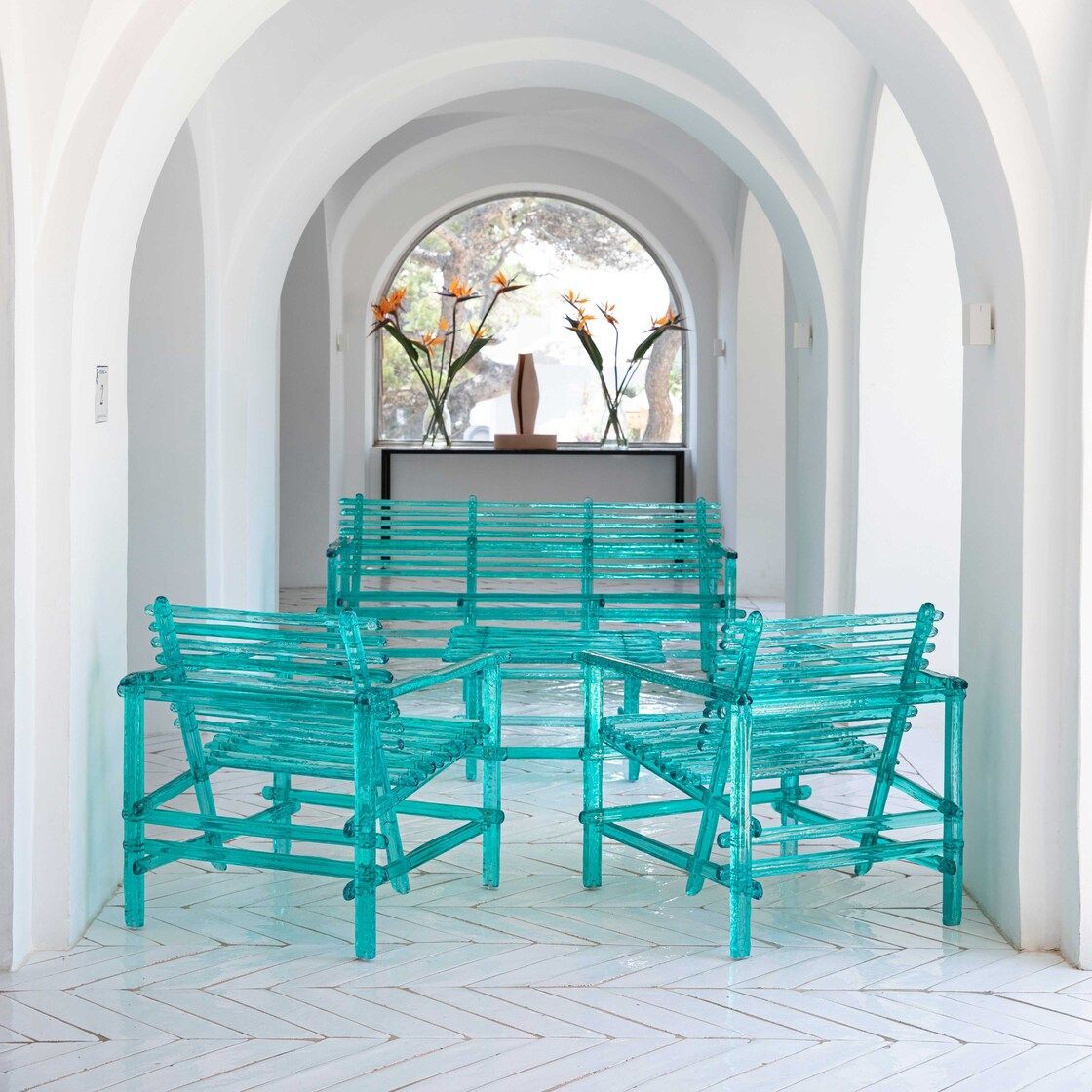
–Ъ–Њ–ї–ї–µ–Ї—Ж–Є—П A’mare –Њ—В—З–µ—В–ї–Є–≤–Њ –≤—Л–і–µ–ї—П–µ—В—Б—П –љ–∞ –±–µ–ї–Њ–Љ –Ї–µ—А–∞–Љ–Є—З–µ—Б–Ї–Њ–Љ –њ–Њ–ї—Г Vietri –Є —Б–Њ–Ј–і–∞–µ—В —Н—Д—Д–µ–Ї—В –≤–Њ–і—Л –њ–Њ–і —Б–≤–Њ–і–∞–Љ–Є –±–µ–ї—Л—Е –∞—А–Ї–∞–і.
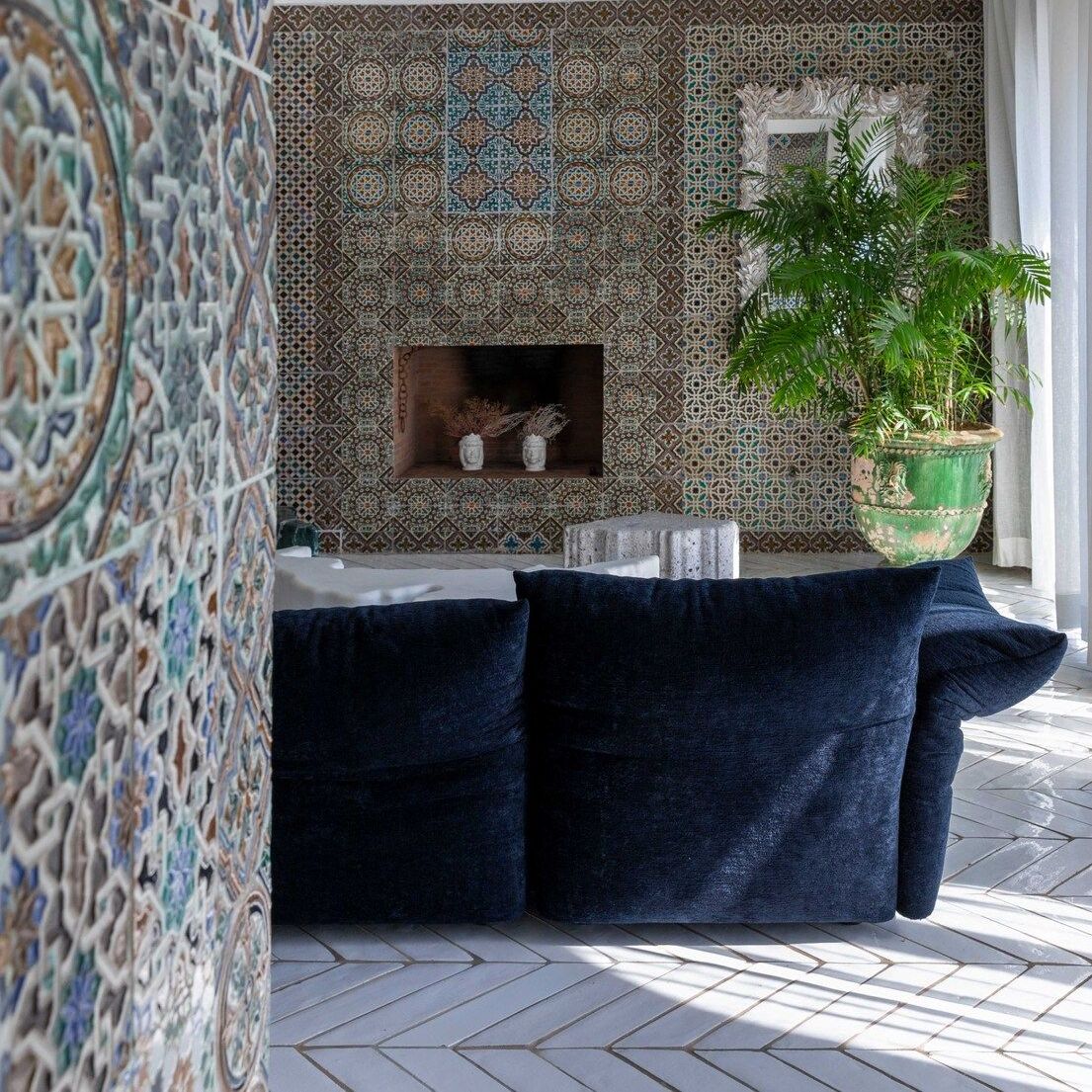
Standard inside one of the rooms of the villa. The colors of the sofa recall the blue tones of the ceramics and wooden doors.
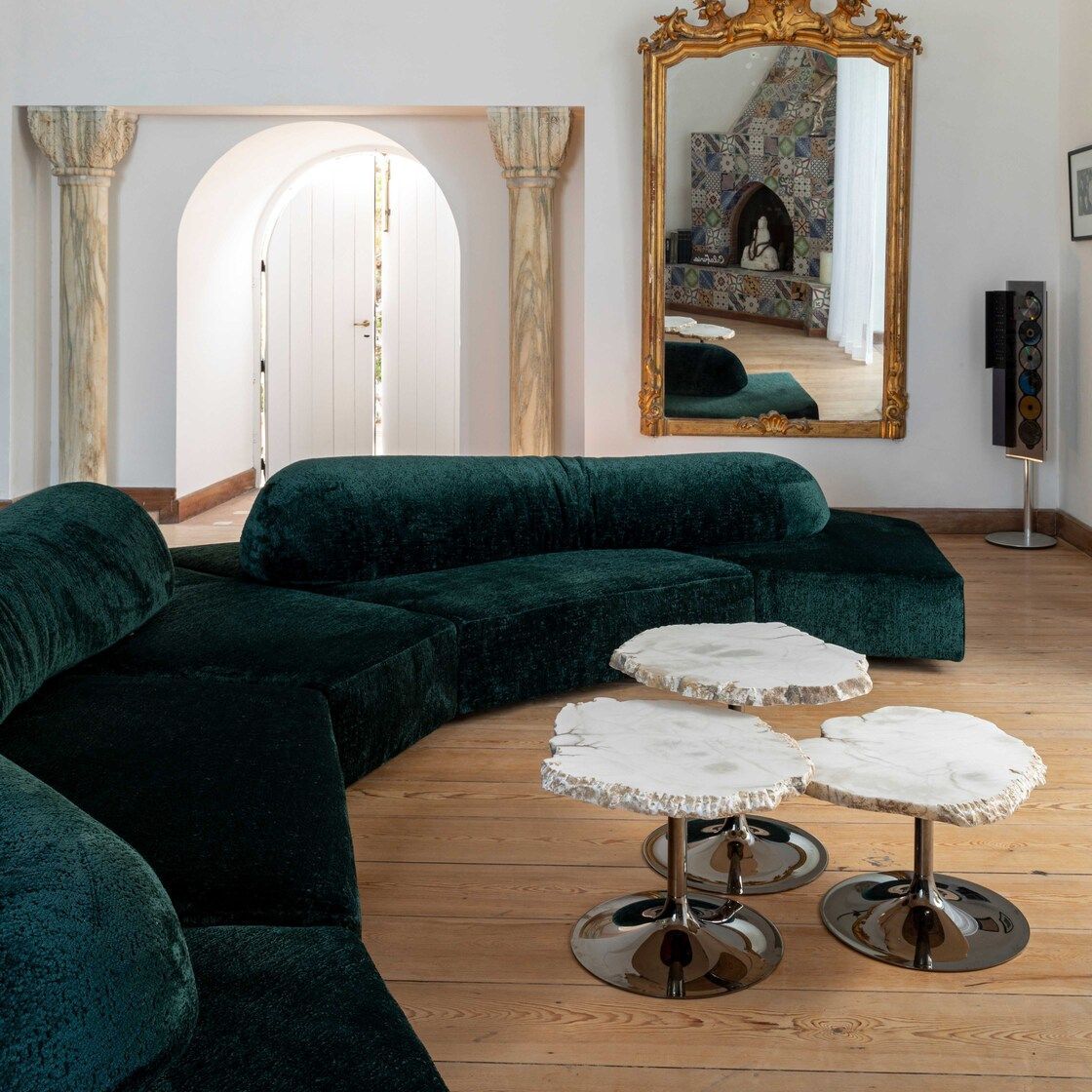
On the Rocks and Cicladi. The sofa by Francesco Binfarè and the alabaster tables by Jacopo Foggini inside the “ballroom” that Léonide Massine had set up in the Saracen tower, where Rudolf Nureyev also danced.
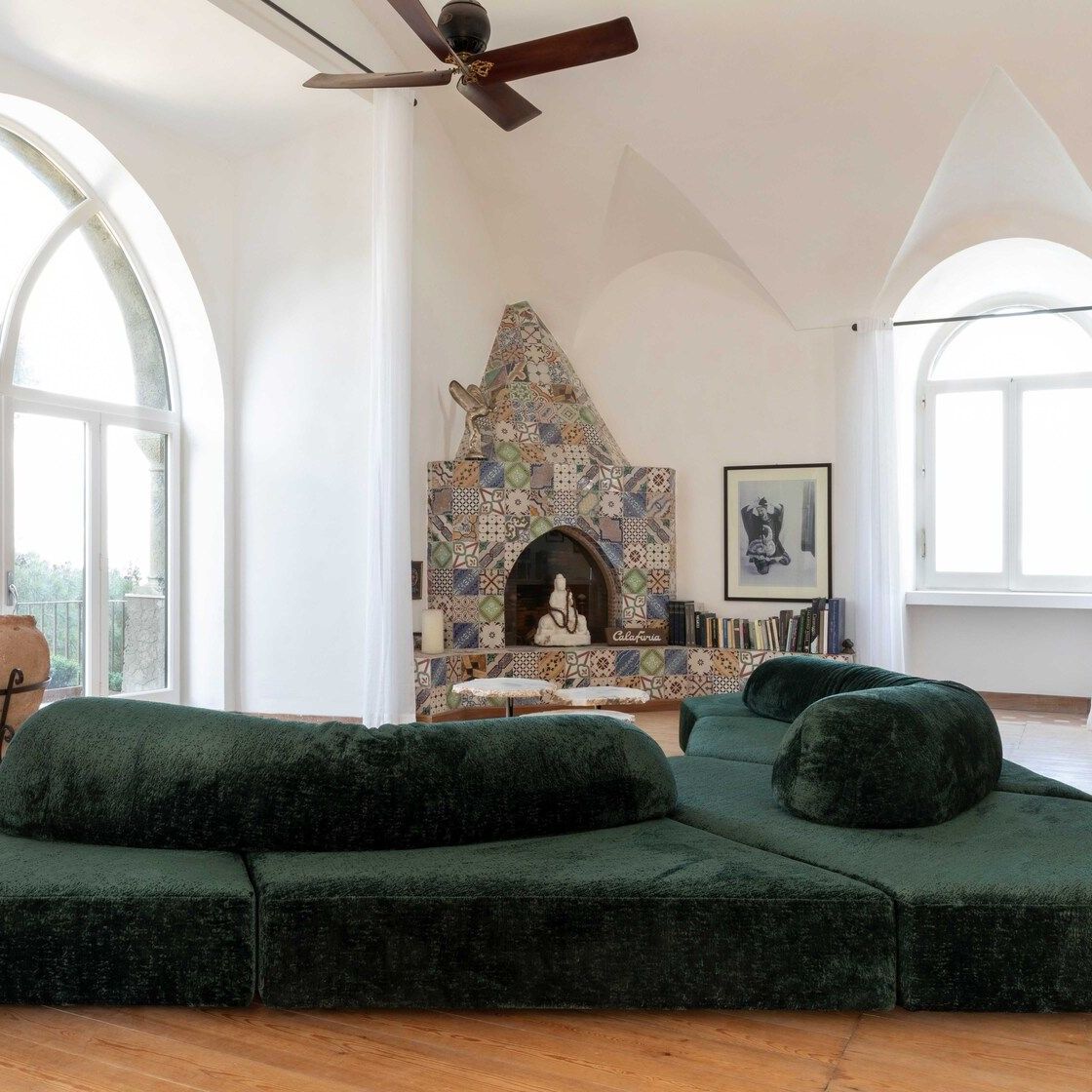
On the Rocks and Cicladi. The sofa by Francesco Binfarè and the alabaster tables by Jacopo Foggini inside the “ballroom” that Léonide Massine had set up in the Saracen tower, where Rudolf Nureyev also danced.
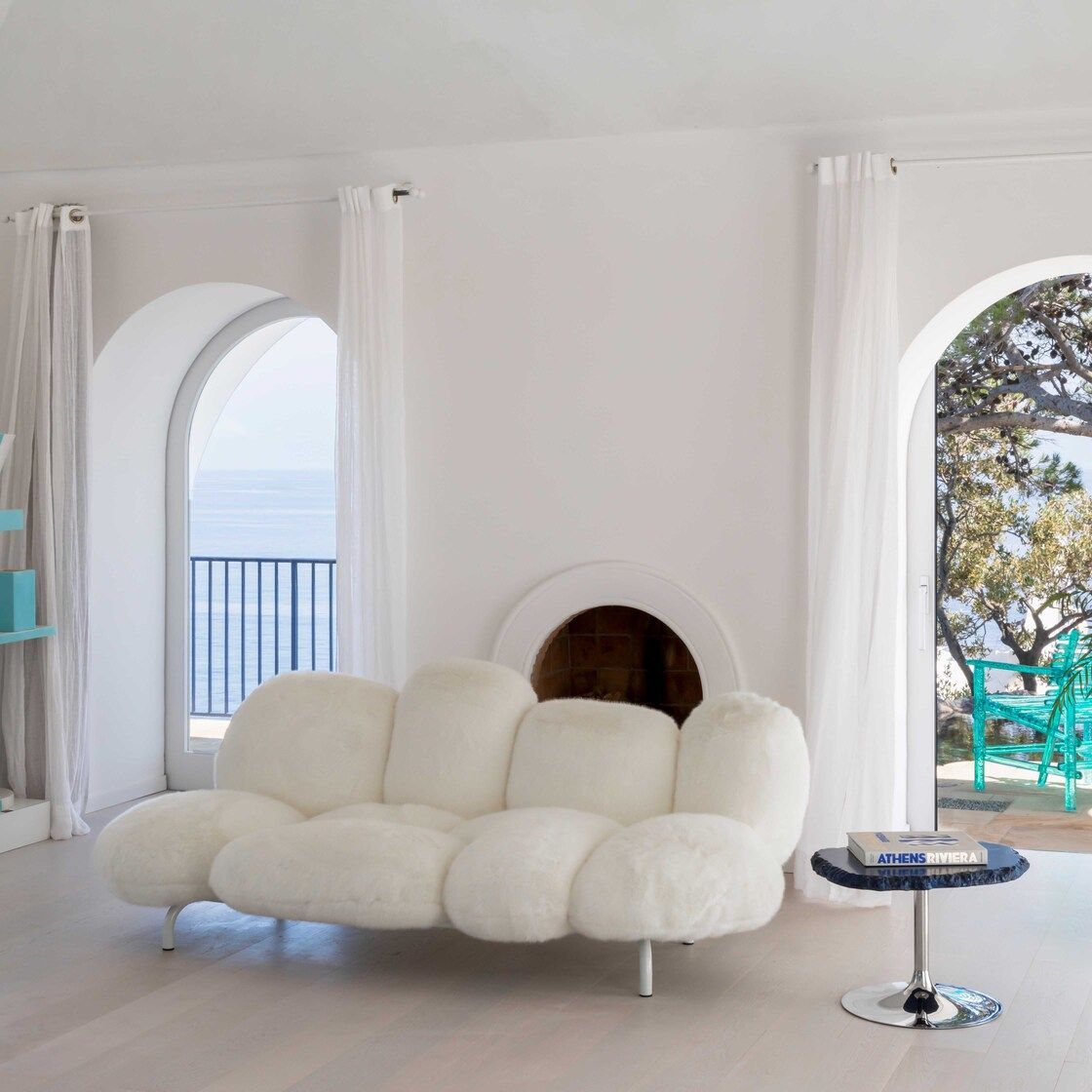
Cipria, Cicladi and A’mare. The sofa by the Campana brothers, the coffee tables and the chair by Jacopo Foggini inside and overlooking the master bedroom. The colors and materials of the furnishings blend in harmony with the architectural and landscape context. On the left the work of Ettore Sottsass Claire de Lune, a ceramic totem in white and turquoise.





